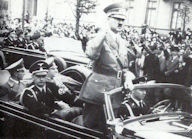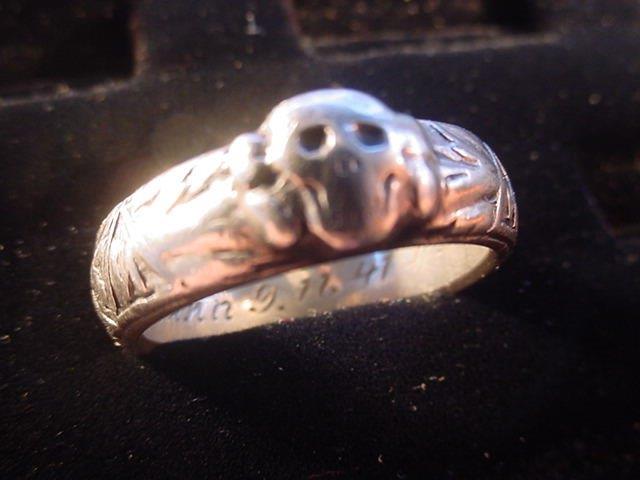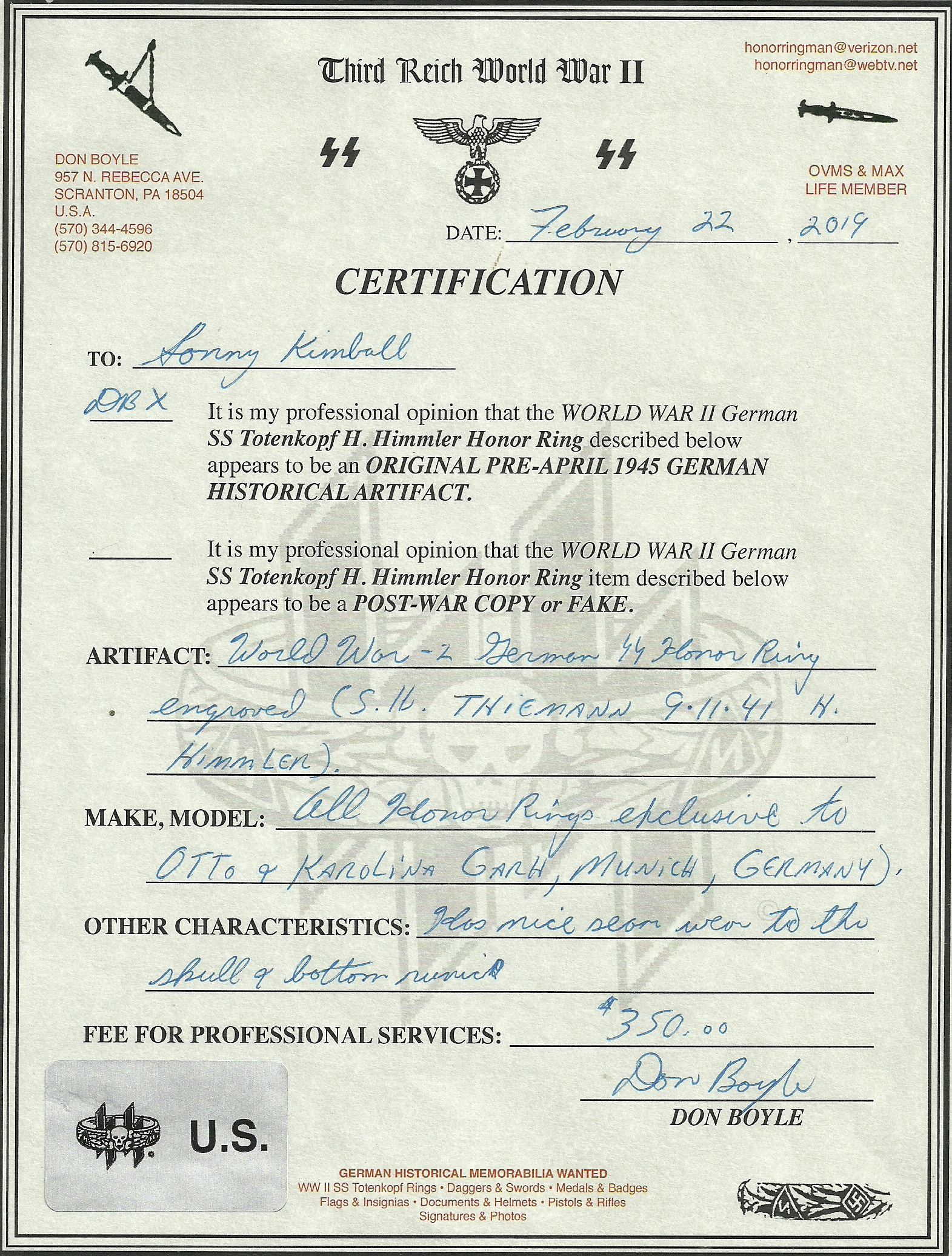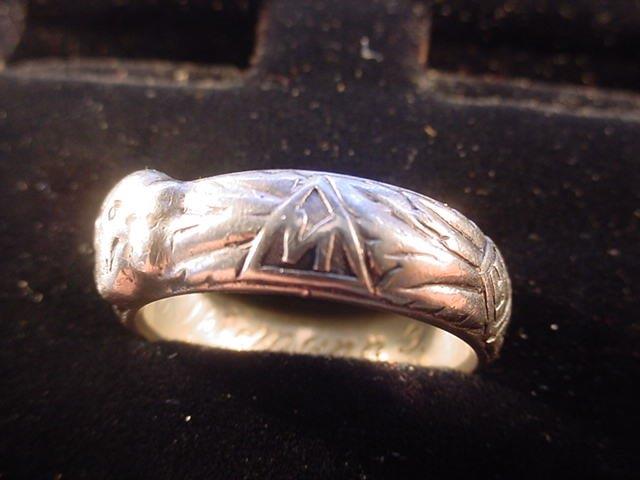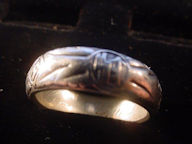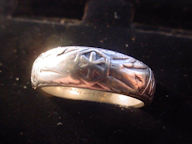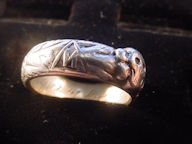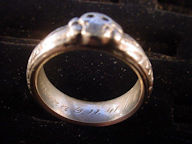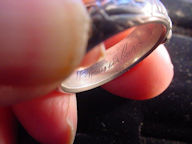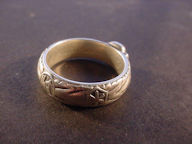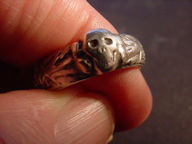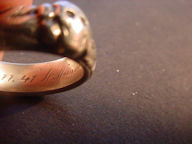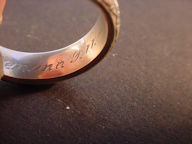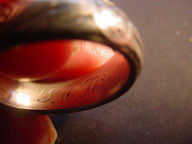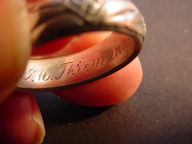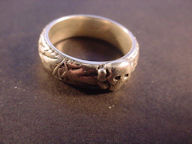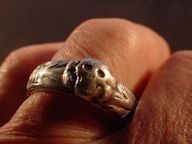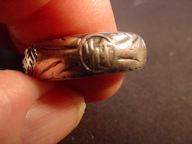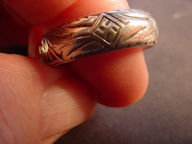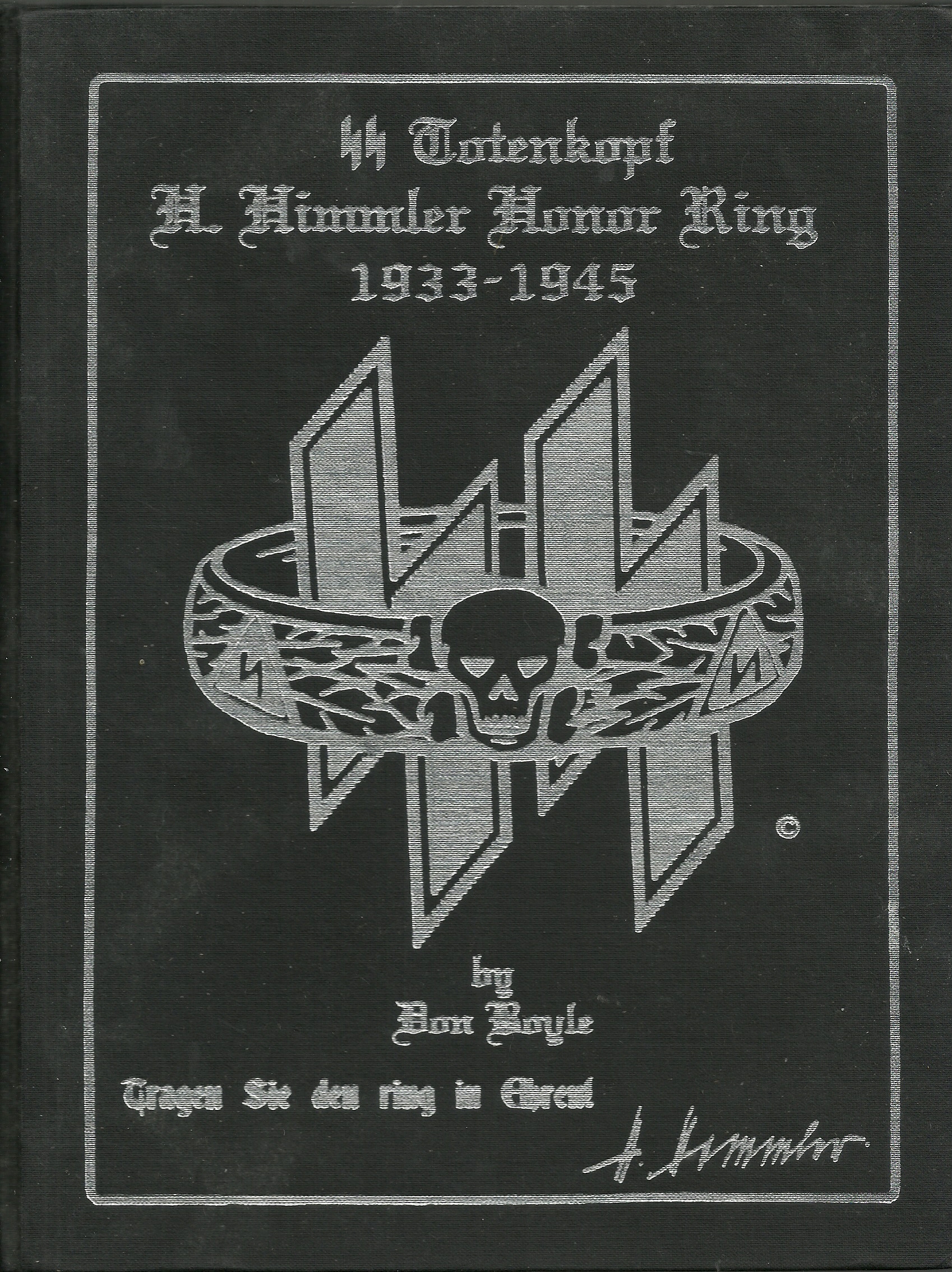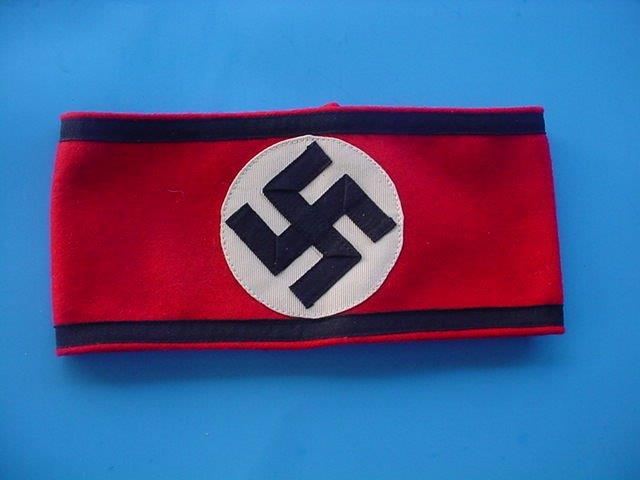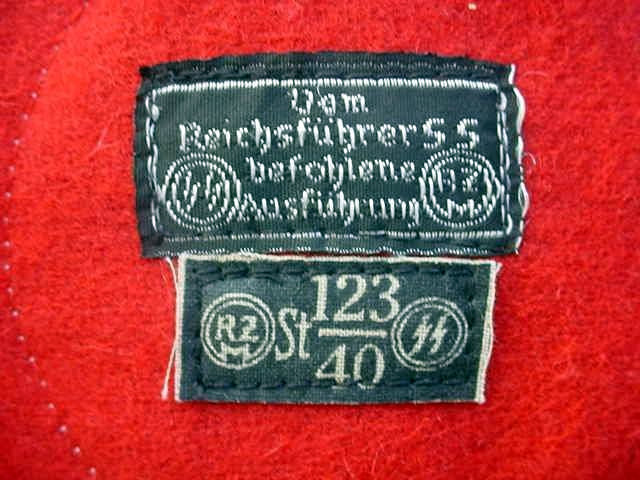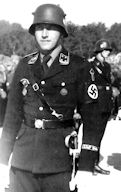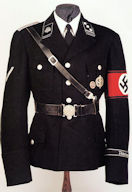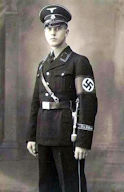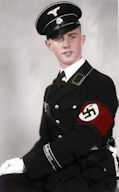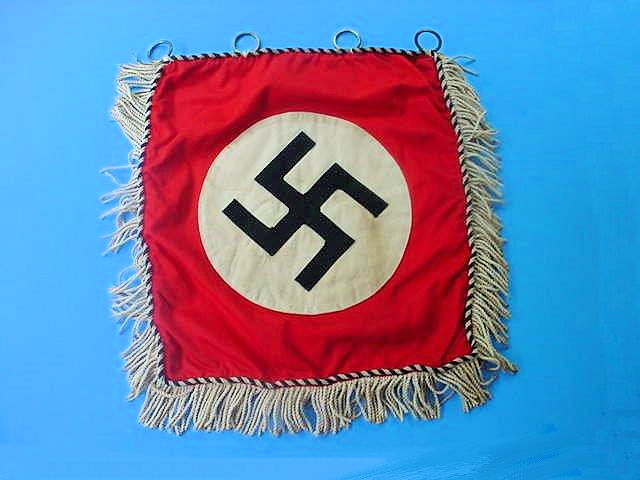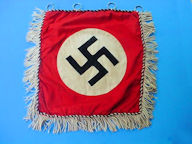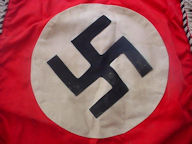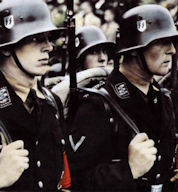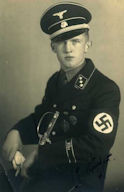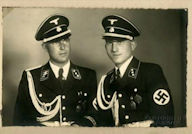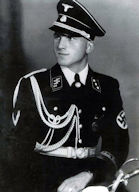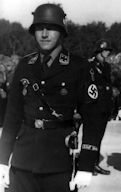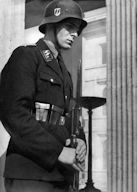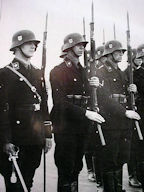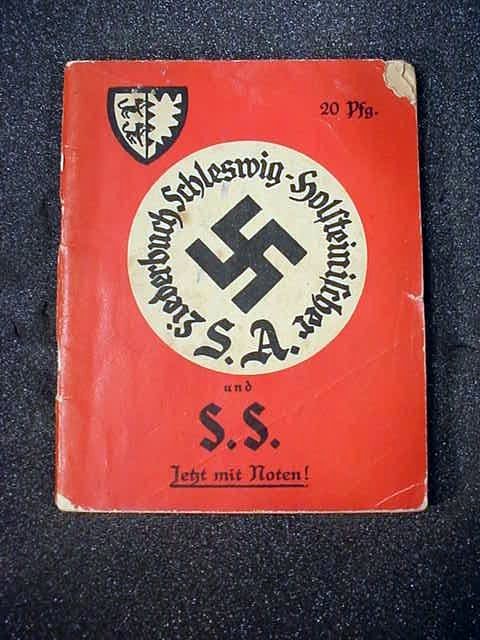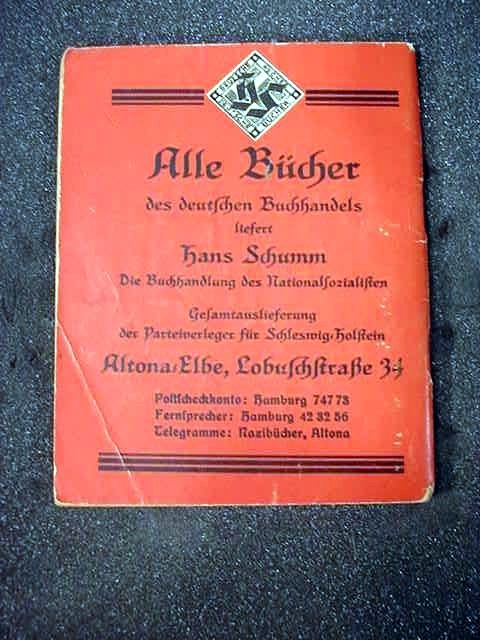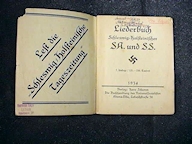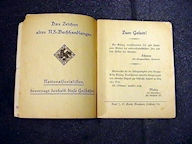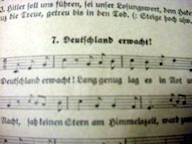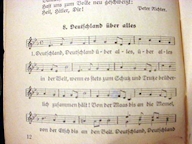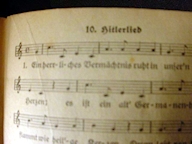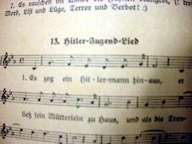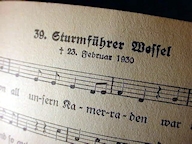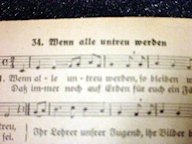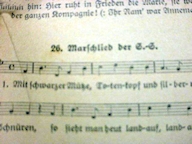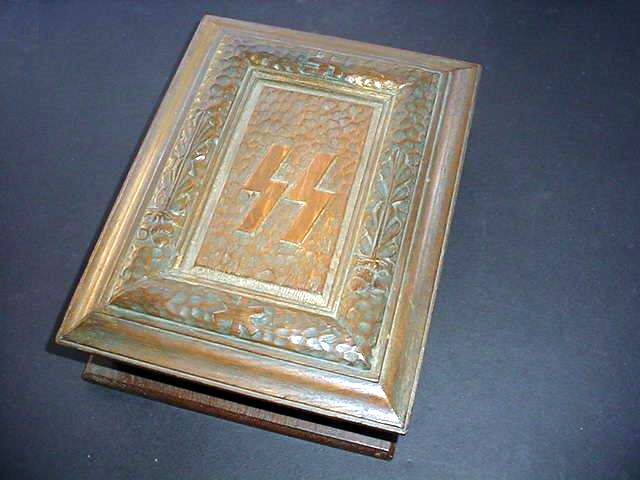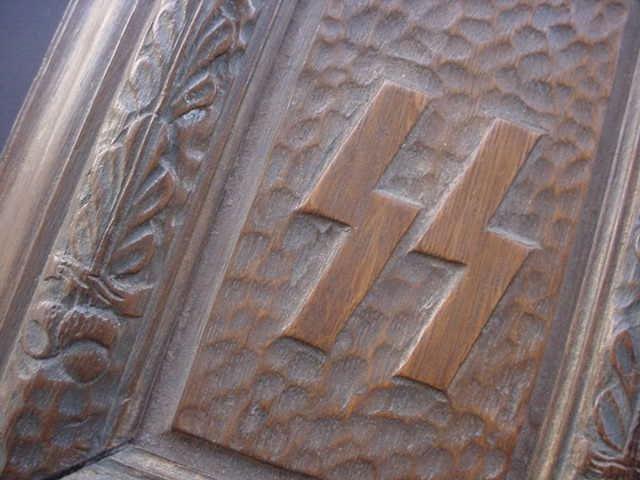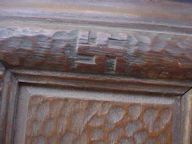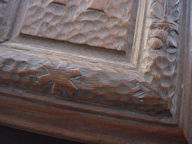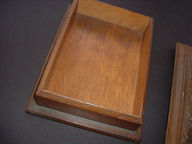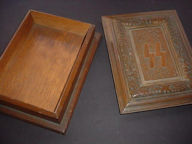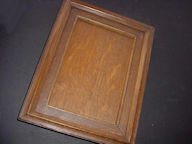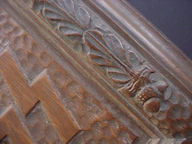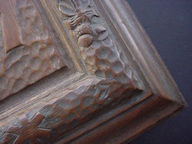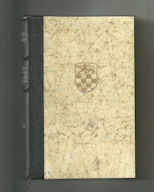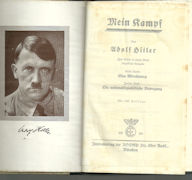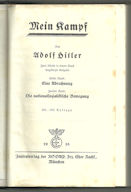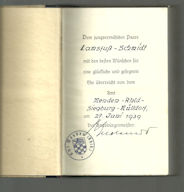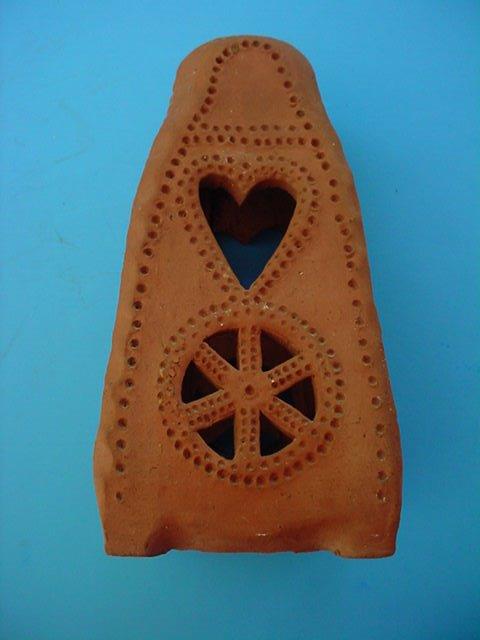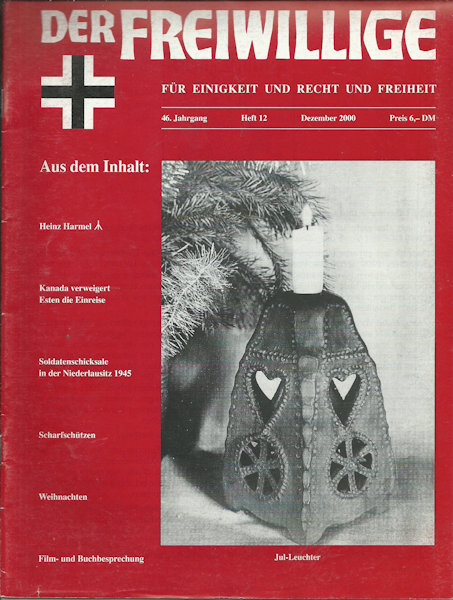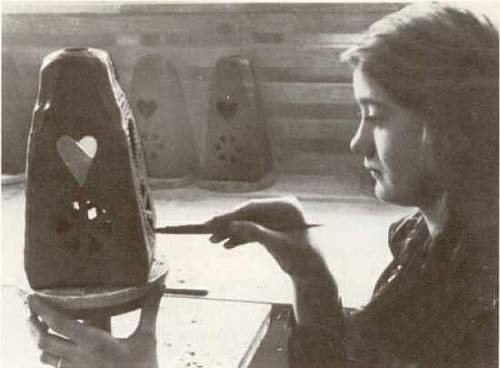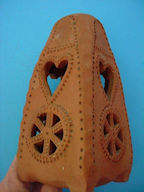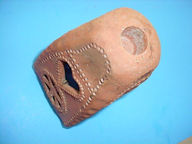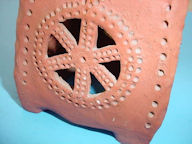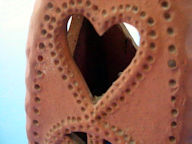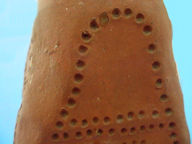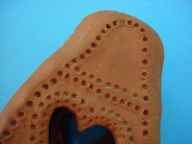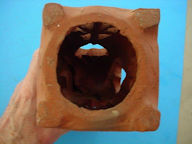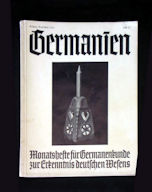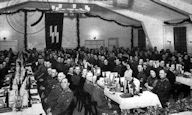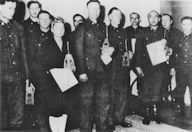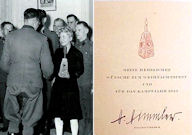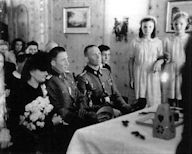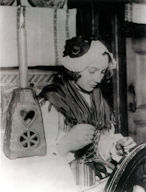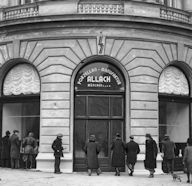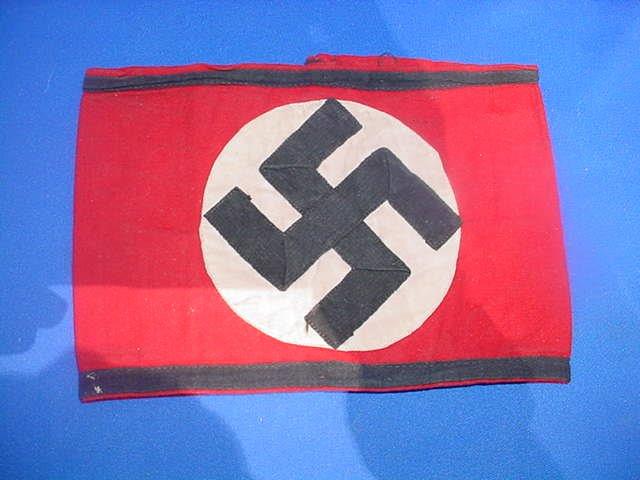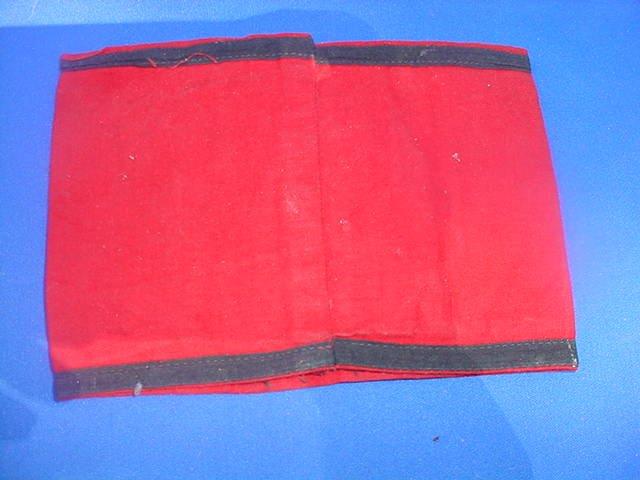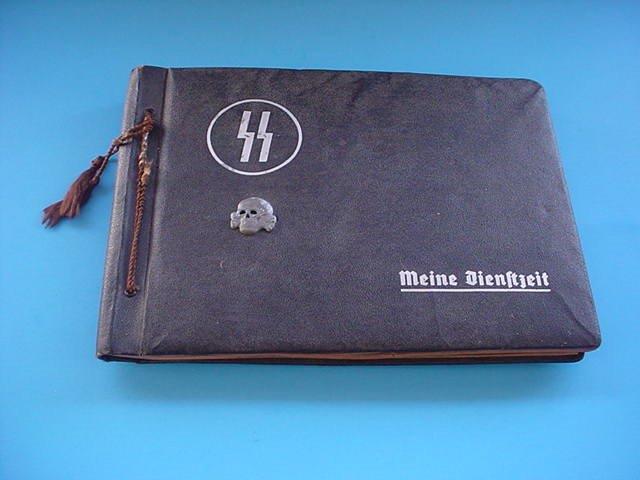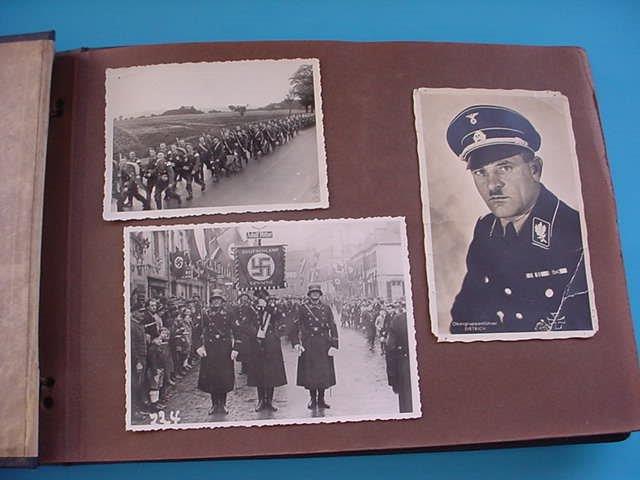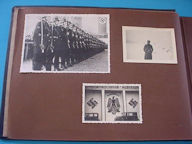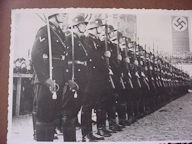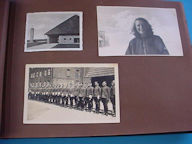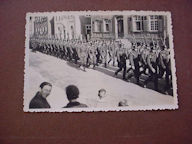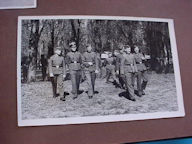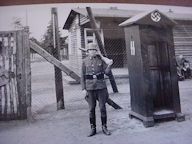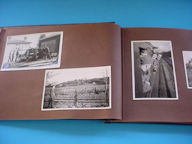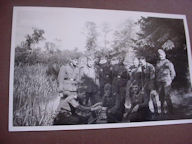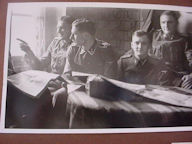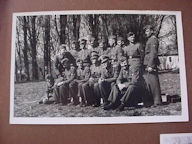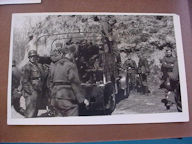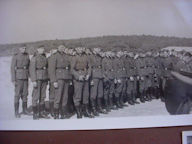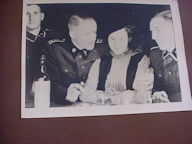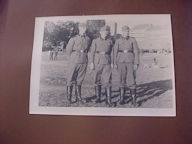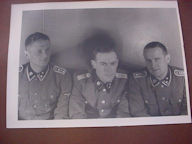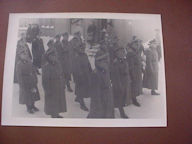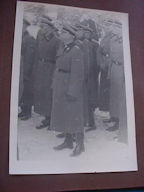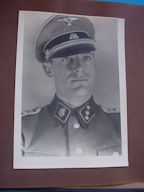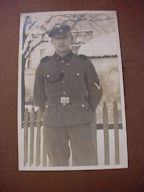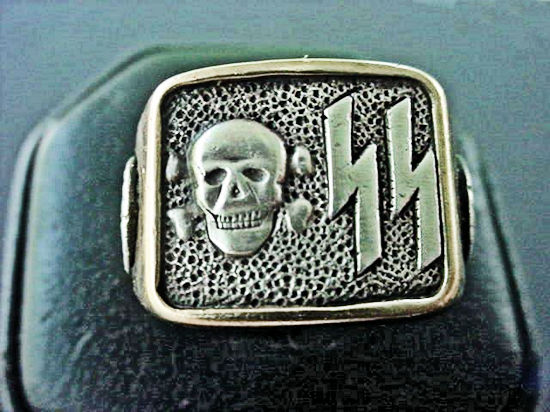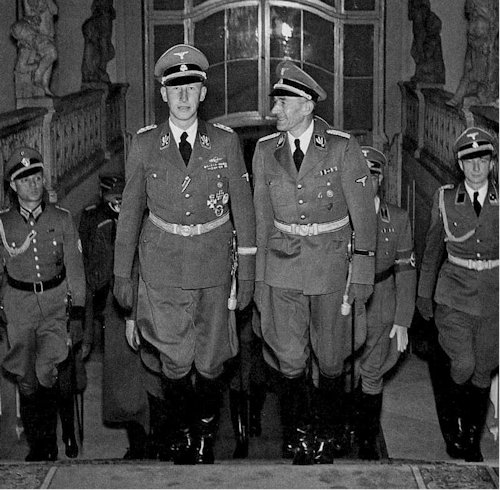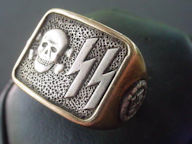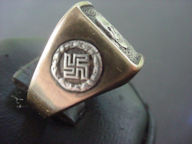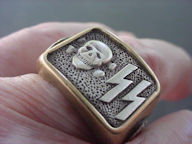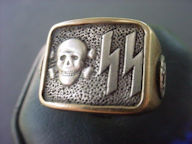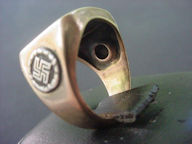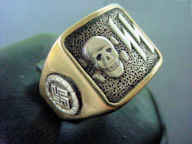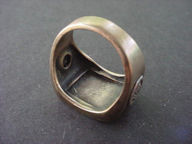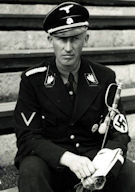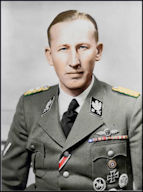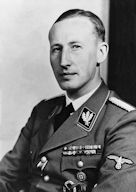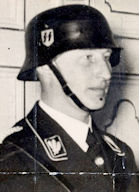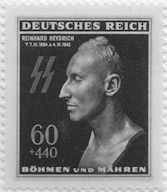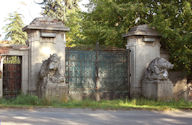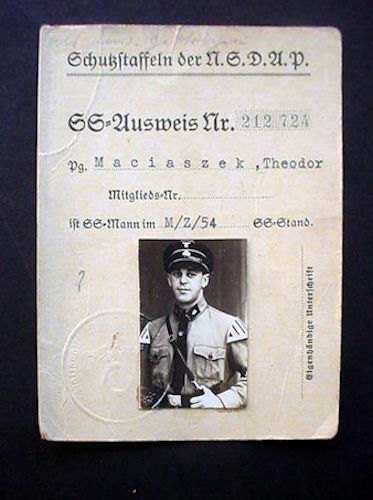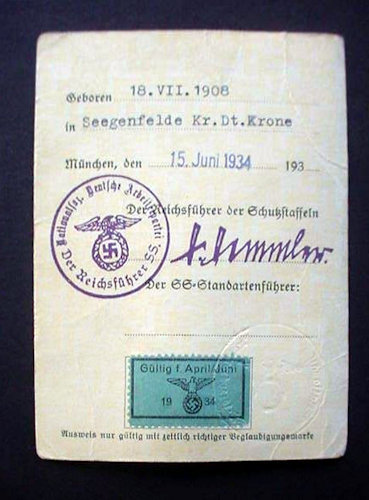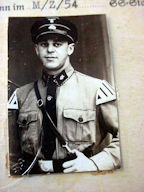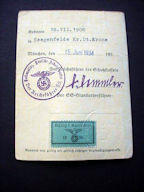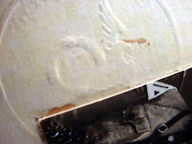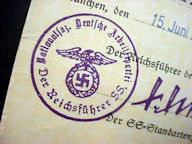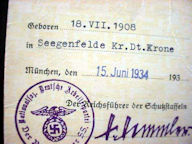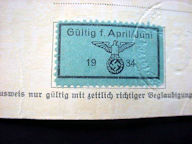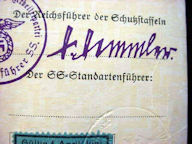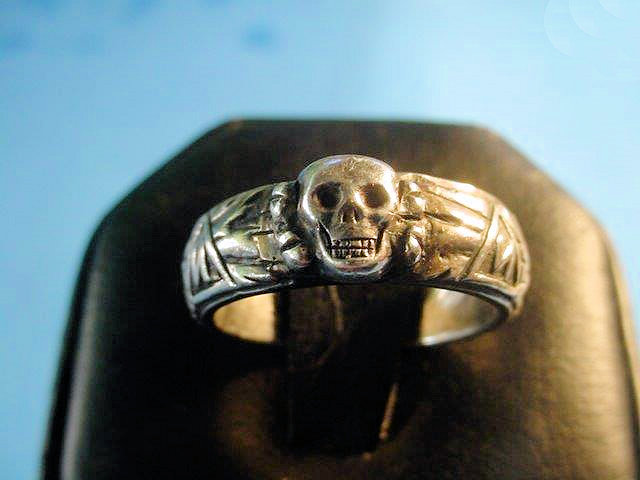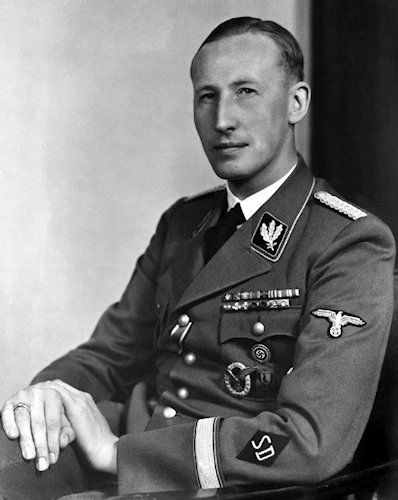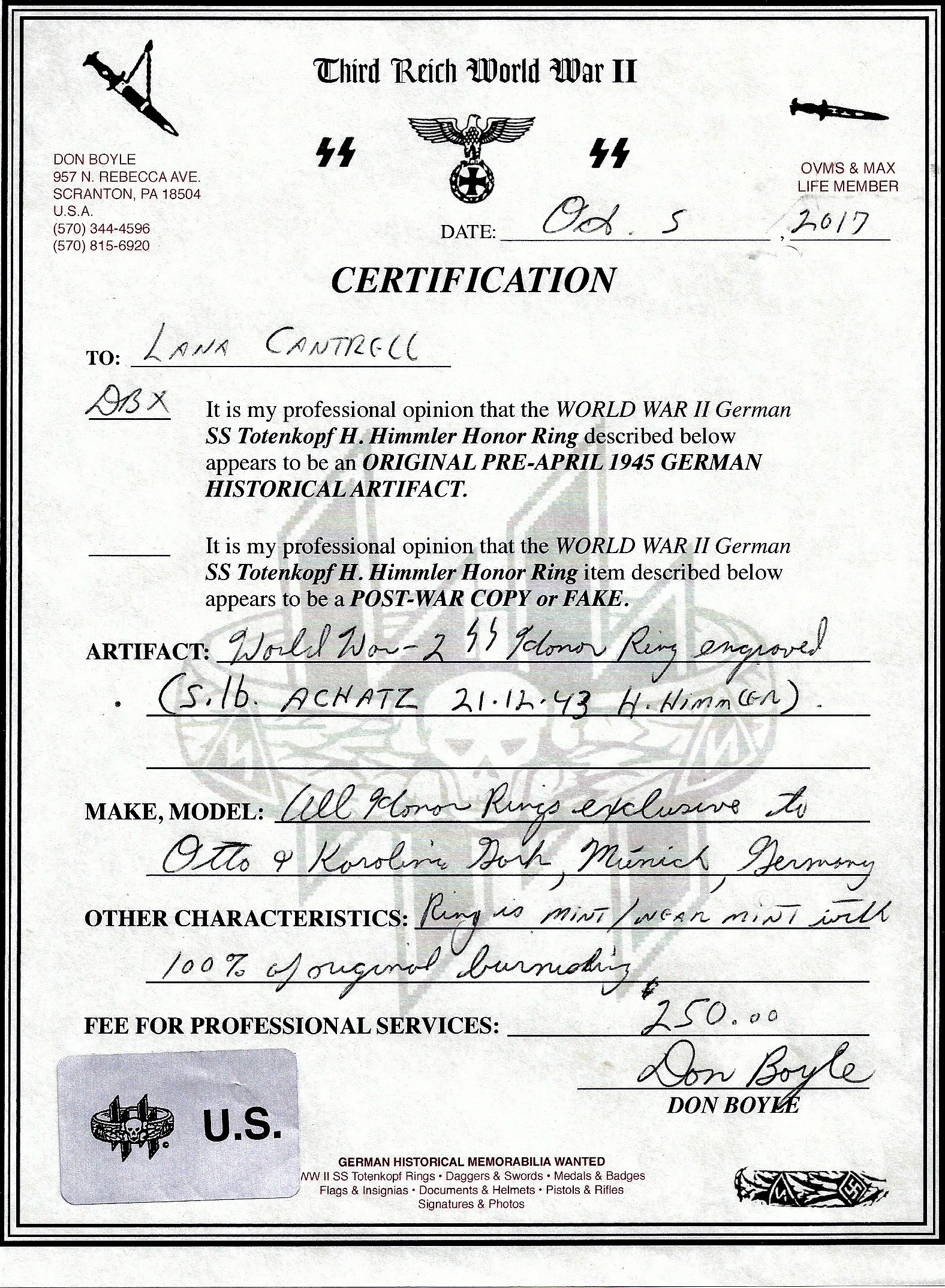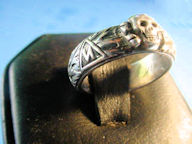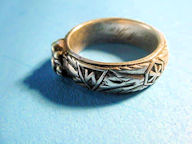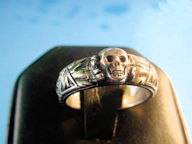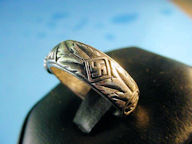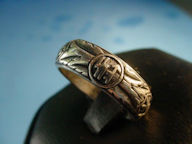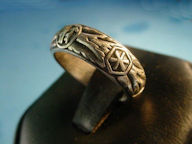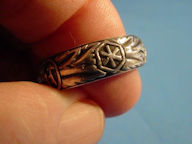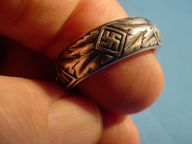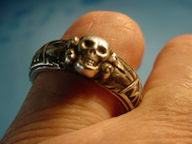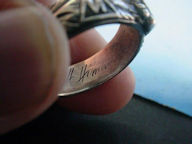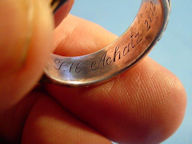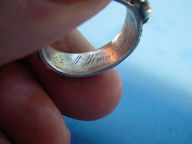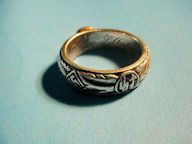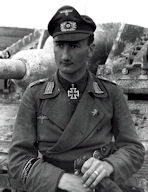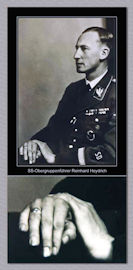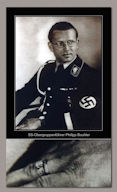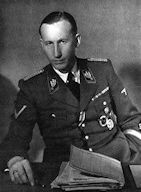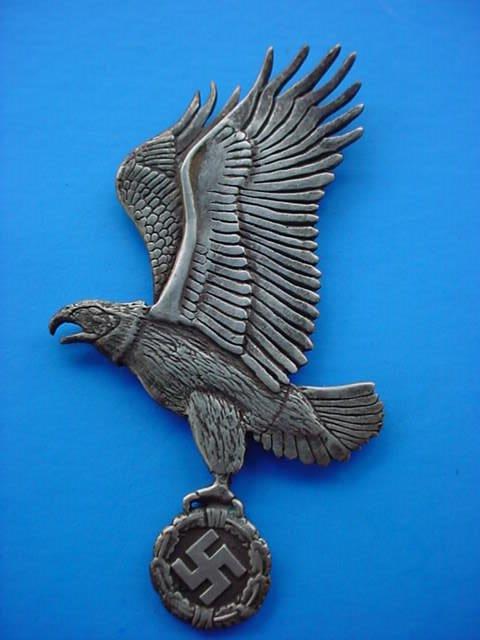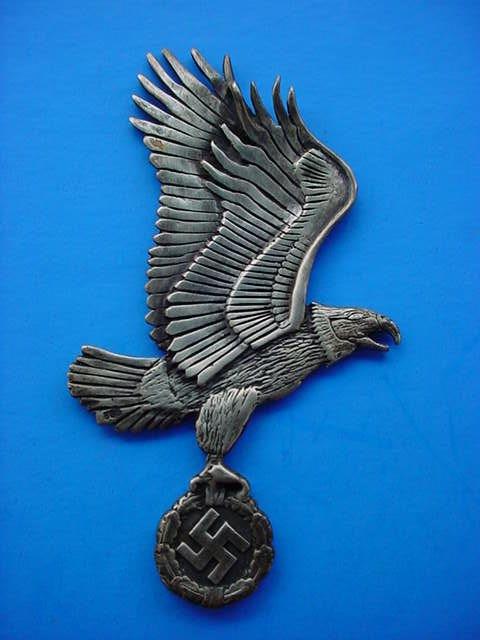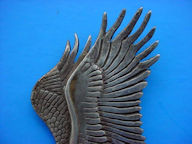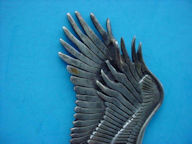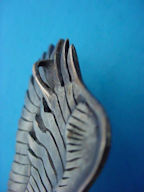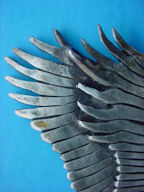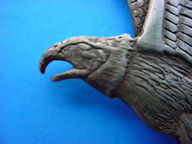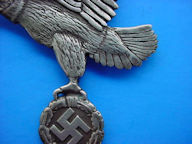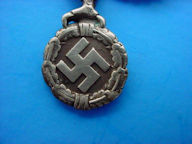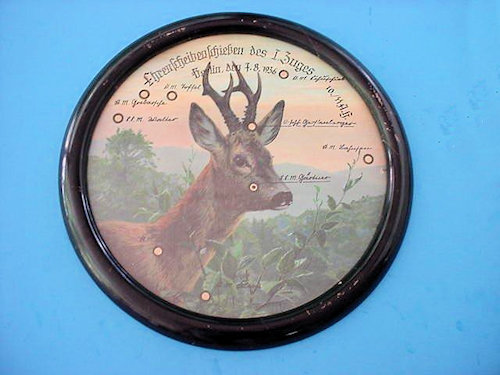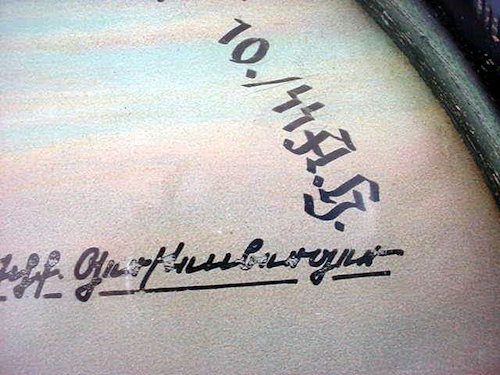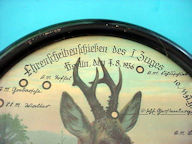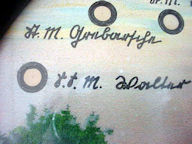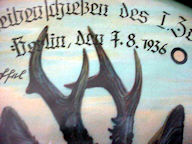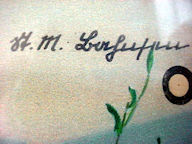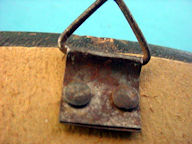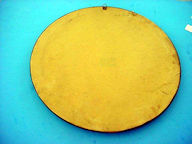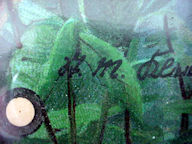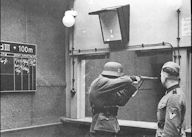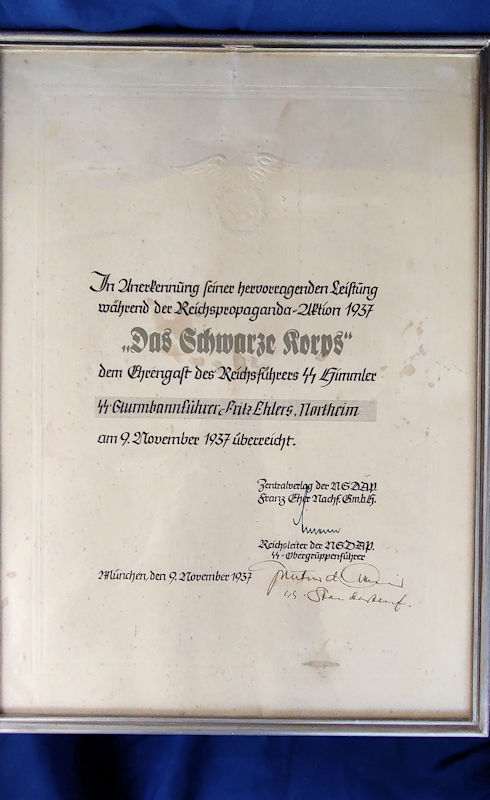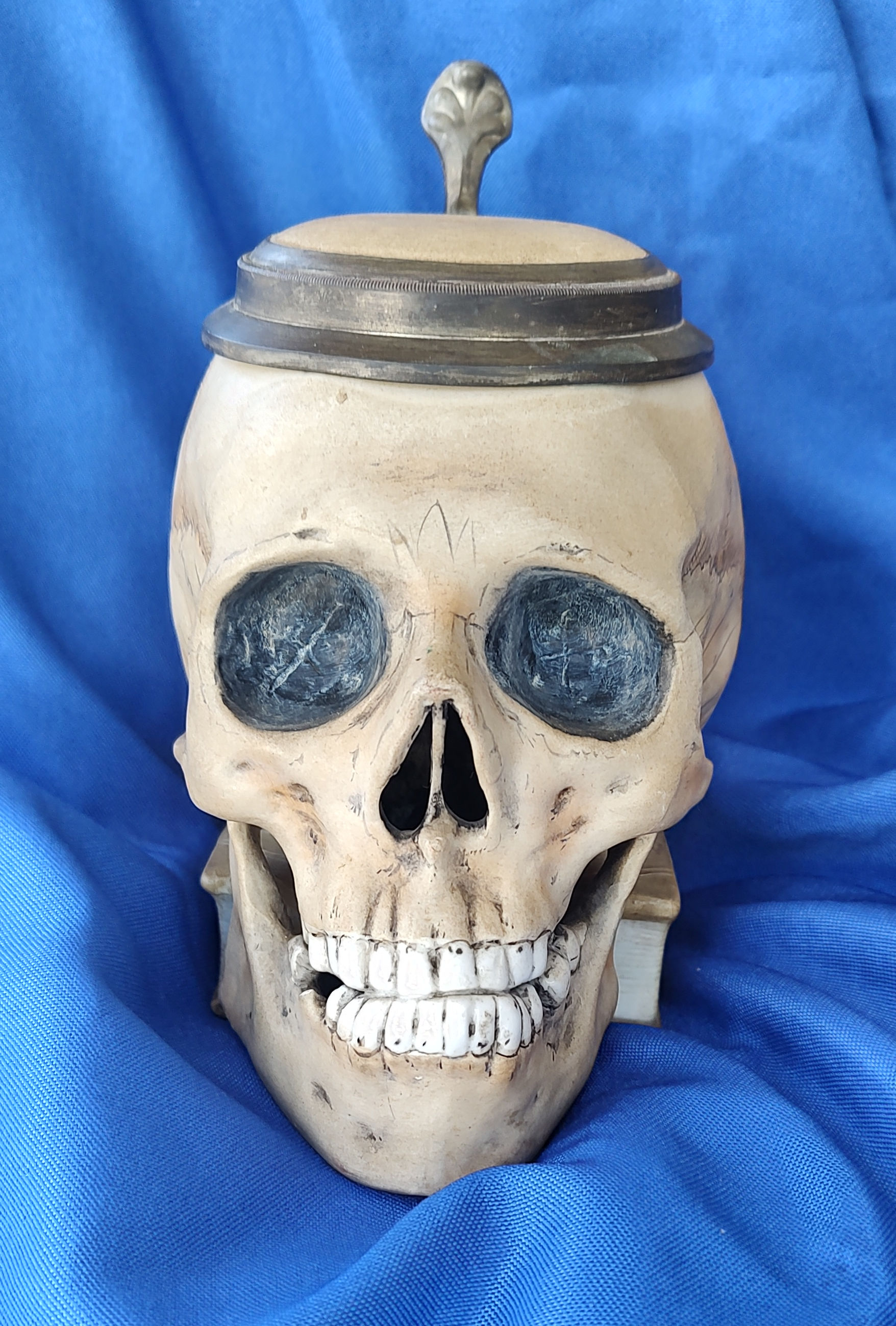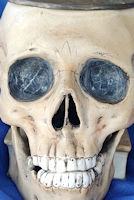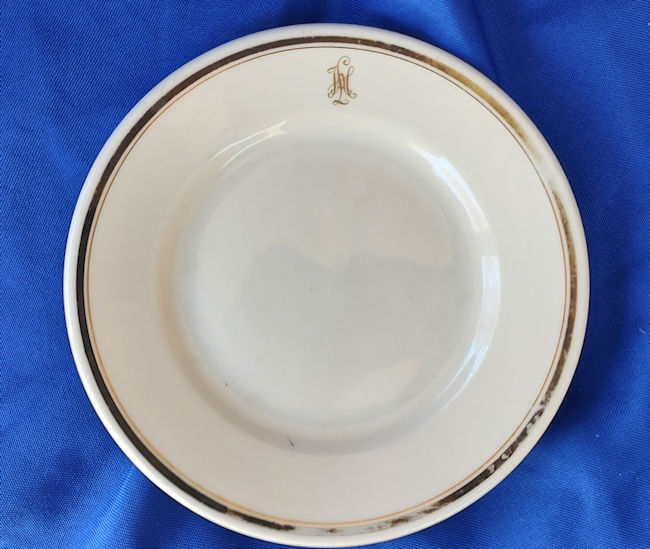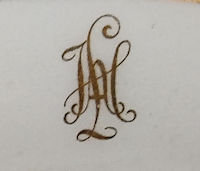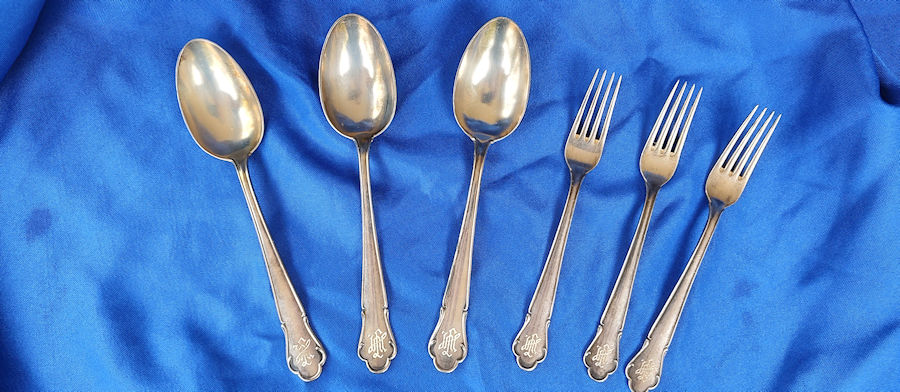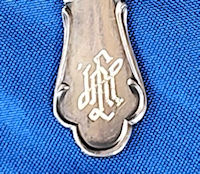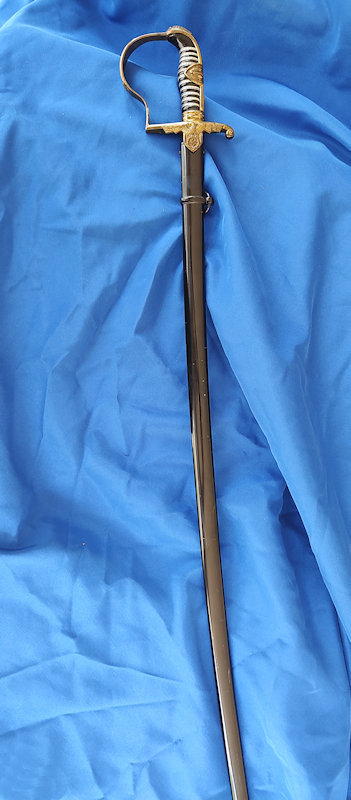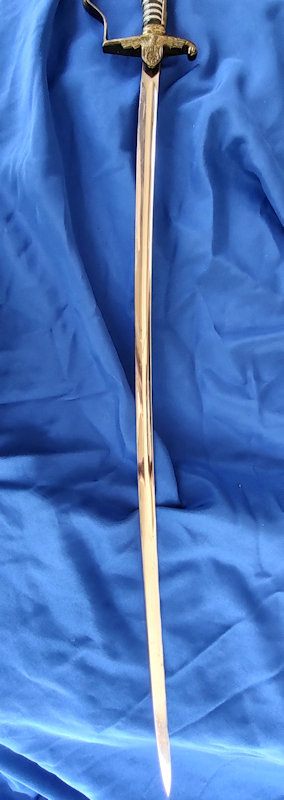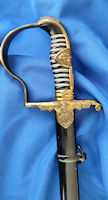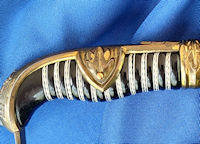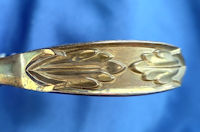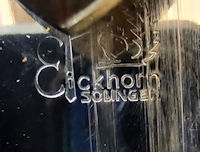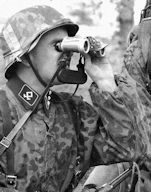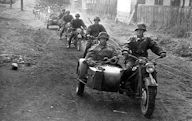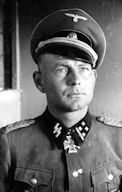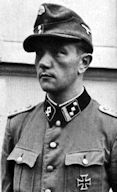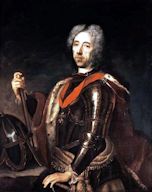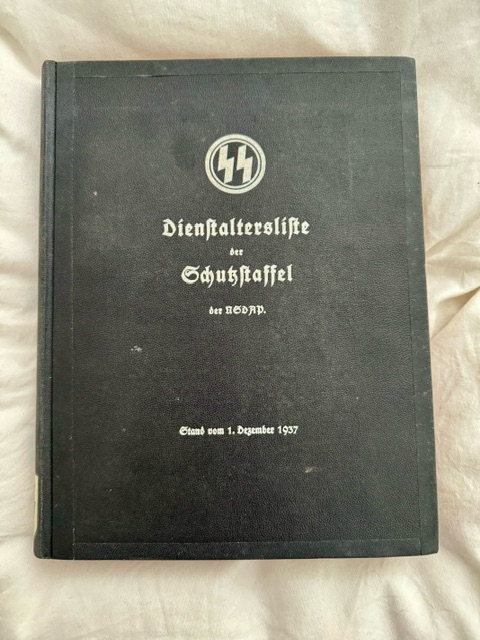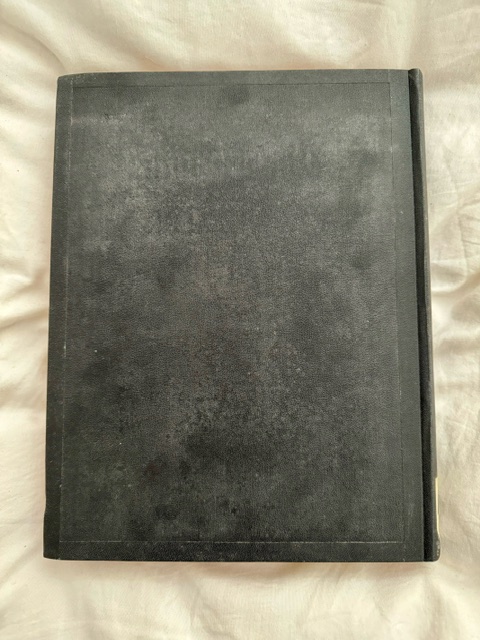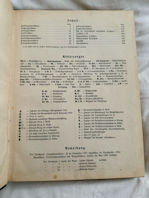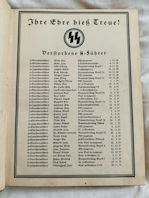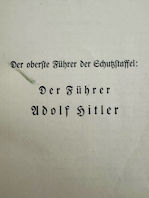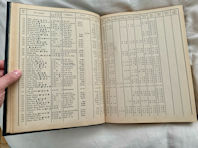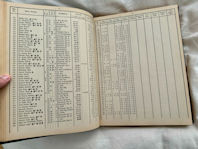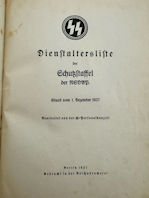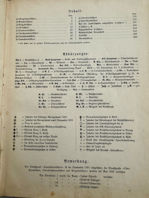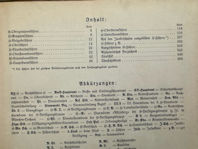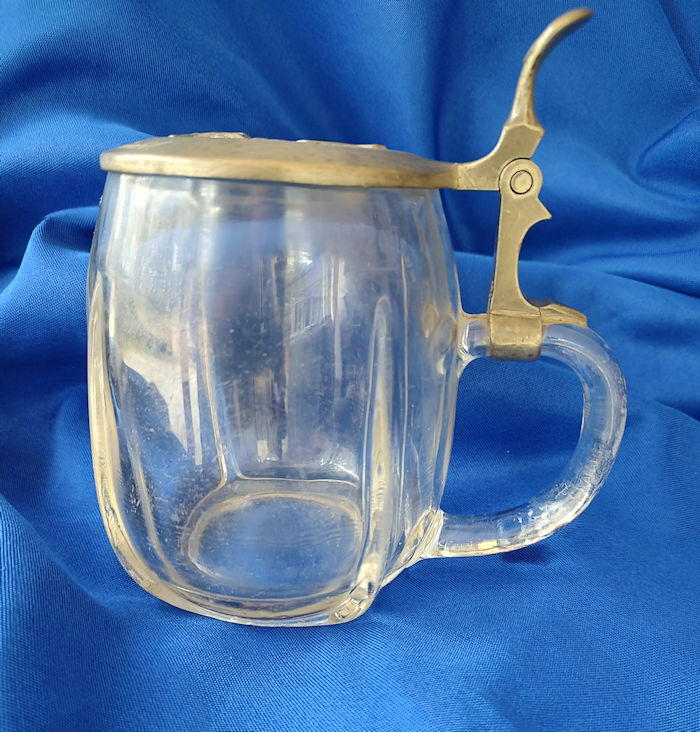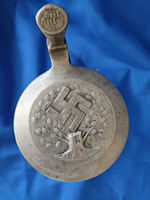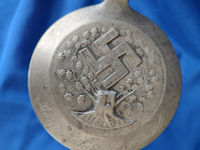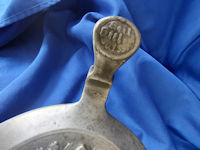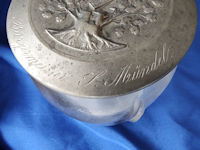|
|
Allgemeine-
Page 38
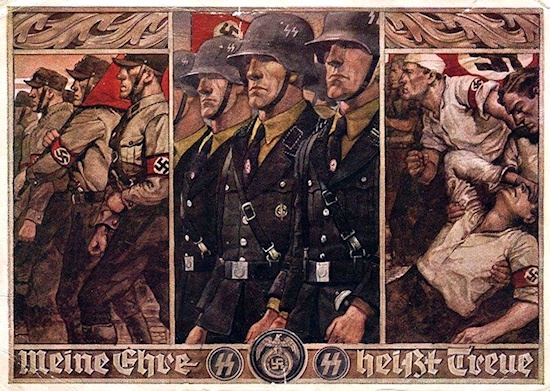 |
|
|
|
Most Handsome Little SS Trooper (Item SS 38-1; NSTOYS 1-2) |
|
DESCRIPTION: Here he is in his full glory immaculately dressed in his kampzeit uniform. Little Hans wears his proper brown shirt (since the SS evolved originally from the SA troops commonly known as brownshirts ). Note his enlisted black collar tabs. He also has his belt with swastika symbol. He sports the traditional black cross strap. His riding trousers are typical of the type worn by the early SS men. He has his shiny boots probably made of oilcloth. On his shirt is the swastika armband and of course there is the black necktie. His face beams with youthful exuberance and patriotism to the cause he adores. For the most part, he is perfect, but somewhere in a street fight with the Rote Front (Communist thugs) he must have lost the cap insignia that was on his kepi. Yes, he looks boyish and mild tempered, but that is what these early elite fighters appeared to look, but they were subject to the words of their Führer: “Swift as a greyhound, as tough as leather, and as hard as Krupp’s steel.” Well, little Hans has tried to live up to that. However, he can come to you minus his cap insignia or here’s an idea: I have an original eagle-and-swastika silver stickpin that might just fill the bill that can be added to little Hans price for $50.00. (It’s a $100 pin, but since we admire him so much we are willing to give a very substantial discount if Han’s new friend desires to purchase it. (See the last image to envision what the cap would look like, if added). In any case, this little trooper is petite measuring a little over 9 inches tall. It’s light as a feather and rarer than a chained SS dagger and certainly much cuter. *It's absolutely original to the Third Reich period.
PRICE: SOLD |
|
||||||||||
|
The Grand OKW “Oberkommando der Wehrmacht” Tapestry (Item SS 38-2; ART 17-19: TAPESTRY 1-3) |
||||||||||
DESCRIPTION: We start this narrative with a statement that should go at the end, and that is: “What could be more important than this magnificent and prodigiously important relic of the Third Reich?” Here is the unique (and I use the term “unique” for its intended definition—“One of a Kind”) Wandteppich (tapestry) that once hung in the headquarters of the Supreme Command of the German Armed Forces. The OKW or Oberkommando der Wehrmacht was the organization that was responsible for all preparations for national defense in time of peace and for the conduct of operations in time of war. The head of the OKW was a cabinet member and represented the joint interest of the three branches: army, navy, and air force with respect to other departments of the government. The OKW was supreme and fully responsible for the coordination of the active war effort by the three subordinate branches, while the OK der Heeres (army) is responsible for all army matters, just as each of the other two high commands—air force and navy—were responsible for the application of general policies within each one's own sphere. In wartime, each high command had a forward echelon and a rear echelon. The forward echelon moves to a location appropriate to the theatre of main operations, while the rear echelon remains in the Berlin area; actually the building was Wündsdorf near Zossen in the outskirts of Berlin. Although it was not as grand as Göring’s air-ministry building on the Wilhelmstrasse it still was a classic example of Third Reich architecture. A branch of the OKW was on the Bendlerstrasse; now named the Stauffenbergstrasse after the traitor Claus von Stauffenberg who was a would-be assassin who planned with other army officers to murder the Führer. When the coup failed he was shot by firing squad on the spot. The fantastic tapestry was either from this HQ or the one in Wündsdorf-Zossen. Many of the very important Third Reich buildings had handmade tapestries within but the total amount couldn’t be over a dozen. We at Germania have owned and found homes for the tapestry’s from the  -Deutsches Ahnenerbe that was located in Berlin, and the Lebensborn tapestry that came from the Steinhöring home known as “Heim Hochland.” We have had several important smaller tapestries as well. The importance of tapestries to the National Socialist mythos cannot be underestimated. “The Norns” were in Norse mythology female beings who ruled the destiny of the gods and men as they spun the thread of fate at the foot of Yggdrasil (the world tree). They weave the threads onto a giant tapestry that predestines the lives of the human species. Recently a writer named Joan Schweighart wrote a story called “Gudrun’s Tapestry” based on Germanic legends. In the days when the church and great royal houses ruled the Germanic world tapestries were symbols of great wealth. Whenever official ceremonies or public celebrations were held, tapestries lent beauty and richness to the events. Bishops and kings welcomed important visitors with red carpets flanked by tapestry displays. Royal processions proceeded along routes flanked and marked with tapestries. So, with tradition being so prodigiously important to the N.S. artistic sense and because of the intellectual state of mind that prevailed, the display of tapestries became extremely aesthetically important to Hitler’s Reich. In the mid 1980s I had occasion to visit with former -Deutsches Ahnenerbe that was located in Berlin, and the Lebensborn tapestry that came from the Steinhöring home known as “Heim Hochland.” We have had several important smaller tapestries as well. The importance of tapestries to the National Socialist mythos cannot be underestimated. “The Norns” were in Norse mythology female beings who ruled the destiny of the gods and men as they spun the thread of fate at the foot of Yggdrasil (the world tree). They weave the threads onto a giant tapestry that predestines the lives of the human species. Recently a writer named Joan Schweighart wrote a story called “Gudrun’s Tapestry” based on Germanic legends. In the days when the church and great royal houses ruled the Germanic world tapestries were symbols of great wealth. Whenever official ceremonies or public celebrations were held, tapestries lent beauty and richness to the events. Bishops and kings welcomed important visitors with red carpets flanked by tapestry displays. Royal processions proceeded along routes flanked and marked with tapestries. So, with tradition being so prodigiously important to the N.S. artistic sense and because of the intellectual state of mind that prevailed, the display of tapestries became extremely aesthetically important to Hitler’s Reich. In the mid 1980s I had occasion to visit with former  -Oberführer and Professor Karl Diebitsch who was the artist responsible for the beginnings of the porcelain art industry known as Allach. He was also the designer of much of the SS regalia including the chained Mod 36 SS dagger. Go to our -Oberführer and Professor Karl Diebitsch who was the artist responsible for the beginnings of the porcelain art industry known as Allach. He was also the designer of much of the SS regalia including the chained Mod 36 SS dagger. Go to our  -Schutzstaffel page and at SS 36-14 find more information on Prof. Diebitsch and the dagger. It was Diebitsch who designed the black SS uniform. He also designed a whole series of tapestries for the SS and other N.S. groups. This fabulous tapestry may well be one designed by this brilliant artist. Another tapestry we have offered is the one known as the Himmler wall hanging. Go to SS 36-15 to see that one, which is the most colorful one we have ever encountered. You will find more information about tapestries there. I mentioned in that article that there was no more a valued article to the Third Reich doctrines than these great wall hangings. Professor Diebitsch designed them and they were constructed by his sister, Elsie Seifert, both in completely woven design or applique, or both. Diebitsch tapestries stood alone in the use of almost iridescent silk cloth used to highlight certain areas of the work with bright gold or silver hues such as you can see between the eagle’s limbs and behind the swastika on this OKW wall hanging. In the Himmler tapestry the gold is very evident and the highlights are the swastikas and oak-leaf branches. -Schutzstaffel page and at SS 36-14 find more information on Prof. Diebitsch and the dagger. It was Diebitsch who designed the black SS uniform. He also designed a whole series of tapestries for the SS and other N.S. groups. This fabulous tapestry may well be one designed by this brilliant artist. Another tapestry we have offered is the one known as the Himmler wall hanging. Go to SS 36-15 to see that one, which is the most colorful one we have ever encountered. You will find more information about tapestries there. I mentioned in that article that there was no more a valued article to the Third Reich doctrines than these great wall hangings. Professor Diebitsch designed them and they were constructed by his sister, Elsie Seifert, both in completely woven design or applique, or both. Diebitsch tapestries stood alone in the use of almost iridescent silk cloth used to highlight certain areas of the work with bright gold or silver hues such as you can see between the eagle’s limbs and behind the swastika on this OKW wall hanging. In the Himmler tapestry the gold is very evident and the highlights are the swastikas and oak-leaf branches. The OKW Tapestry This beautiful tapestry bears the stylized Wehrmacht eagle separately sewn on. The eagle looks to its left and clutches an oak-leaf wreath with four Teutonic swords crossing each other behind the wreath. The eagle’s limbs and talons are accented, as is the swastika with gold-bullion cloth that gives it a rather three-dimensional effect. The uppermost portion displays a curved bandeau while the underside has a decorative oak-leaf braid and numerous applied rosettes. Both sides have pressure marks from a frame that had contained it (when?) The wall hanging lay for decades in a small Russian museum outside Moscow and recently it was bought by our German picker and thus returned to Germany and is now in the U.S. This may be the most important tapestry of Third Reich origin ever offered. It is a big 16 x 8 feet (192 x 96 inches or 490 x 245 cm). Let it be said that only Germania International could bring such fabulous articles forth to the collecting public. PRICE: For now it will be priced upon request. Serious inquiries only. |
|
|||||||||||
|
The Book of Love signed by Heinrich Himmler (Item SS 38-3; HH 4-18; PERS 7-1) |
|||||||||||
| DESCRIPTION: The book is by Werner Jansen and is titled Das Buch Liebe published by Georg Westermann in Braunschweig with copyright date of 1920. It comprises 304 pages. The cover is in green cloth with gilt title on the spine, and a small tear on the edge of the spine (fixable!); otherwise, fine. This is a presentation to Heinrich Himmler, inscribed to him on the front flyleaf with: “Oberwachtführer of the Rote Kreuz (Red Cross) Ilse Doehring with friendly greetings November 1940.” Beneath this Himmler has added his ownership signature: “H. Himmler.” This epic saga was dedicated to young women whose men were at the front during WWI. The author, Werner Jensen, and this work were very dear to Himmler’s heart in 1924. After first reading it Himmler declared this book, “. . . the songs of songs to the Nordic woman.” He said, “This is the ideal image we Germans dream of in our youth and are ready to die for as men.” (‘Very good’ and historically important to the extreme.) It shows the obvious sentimentality of the Reichsführer-SS. This is not only revealing, but Himmler's signature is one of the boldest and best of his that we have ever seen. He was obviously proud to own this book.
PRICE: SOLD |
|
||||
|
Beautiful Little Eagle Device for Staff Car (Item SS 38-4; NSD 21-21) |
||||
| DESCRIPTION: Here is the nicest little N.S. eagle that would be the topper for a command-car fender pennant as used by a commander in the SA or by a political leader. It could even be used by ranks of the SS like an SS-Gruppenführer or Obergrüppenführer This is a little charmer indeed; petite, but it exerts importance and is certainly a quality production. 100-percent original and in mint condition. The base is threaded for tight insertion on the staff. If really neat items are your bailiwick, here it one!
PRICE: $450.00 |
|
||||||||||
|
Meine Ehre heist Treue! (My Honor is Loyalty!) Hand-carved Desk Plaque (Item SS 38-7; WAF 14-9, ART 18-4) |
||||||||||
| DESCRIPTION: This is an absolutely beautiful example of the woodcarver’s art. It was possibly done by hand in the Black Forest . . . or . . . was it done by machine? Regardless, it shows fantastic ingenuity. No one who has seen it can actually make an educated guess as to the procedure used. It is absolutely incredible. I personally believe it was carved by hand, or machine by a master carver and it was presented and used on the desks of high-ranking SS officers, probably on Heinrich Himmler’s staff.
The words are the official motto of the SS going back into the 1920s, and these Allgemeine-SS and Waffen-SSmen lived by this oath even to the death! These were also the words on the blades of the SS daggers. The carving on its wooden base is 17 inches long and the base is 2 inches wide. The capital letters are about 1½ inches high, while the small letters are about an inch high. The piece is in perfect shape throughout and is stunning in its beauty. This is Germanic SS art at its zenith and is a real treasure with iconic meaning.
PRICE: $2,500.00 |
|
||||||||||||||||||||
|
Allgemeine- |
||||||||||||||||||||
DESCRIPTION: This cap is in fantastic quality with black tricot wool material and Presstoff (replacement leather) chinstrap–that is correct!–and the “RZM SS” is stamped on the visor. This cap has a fully lined interior with orange-tan oilcloth to the crown and orange-tan cheesecloth to all the body lining. The crown lining has the original clear celluloid sweat diamond intact with the large gold-tone circle with the  runes. The size tab was never added, but be assured the cap is a small size. The inner sweatband shows the pattern for ventilation holes, but they were never punched through (We have seen them patterned like this.) The sweatband is intact and under it to the side is the black oilcloth RZM tag–Tuchmütze runes. The size tab was never added, but be assured the cap is a small size. The inner sweatband shows the pattern for ventilation holes, but they were never punched through (We have seen them patterned like this.) The sweatband is intact and under it to the side is the black oilcloth RZM tag–Tuchmütze  with the manufacturer’s numerical code “45” and the RZM number “353721.” This is without a doubt the finest one we have ever seen and we try to refrain from using the term “mint,” but with this one, there would be no other possible way to describe it. Even the aluminum SS eagle and skull are in pristine condition with original, dull patina. The visor is correctly made of a synthetic composition material and smartly shines in beautiful brilliance. Overall, any serious SS collector would truly relish this cap. How often have you ever seen a mint original offered at any price? with the manufacturer’s numerical code “45” and the RZM number “353721.” This is without a doubt the finest one we have ever seen and we try to refrain from using the term “mint,” but with this one, there would be no other possible way to describe it. Even the aluminum SS eagle and skull are in pristine condition with original, dull patina. The visor is correctly made of a synthetic composition material and smartly shines in beautiful brilliance. Overall, any serious SS collector would truly relish this cap. How often have you ever seen a mint original offered at any price?
PRICE: SOLD |
|
|
|
|
SS Officer’s Degen (officially Ehrendegen Reichsführer-SS) (Item SS 38-10; SSDAG 2-5) |
DESCRIPTION: The SS-Ehrendegen, also SS-Degen, was a straight sabre or dress sword worn with the Schutzstaffel (SS) uniform from 1935 until 1945. First introduced in 1935, it was designed by Professor Karl Diebitsch, who founded the SS Allach porcelain manufacture and was Himmler’s reference on all art and design in the SS. The Degen was originally manufactured by the firm of Peter Daniel Krebs in Solingen, Germany—the one we offer here is one of those Krebs masterpieces. The officer Degen was officially awarded with a hand-signed certificate to hand-selected officers of the SS-Verfügungstruppe and the SS-Totenkopfverbände in recognition of special merit. It was also awarded to officers who graduated from the SS-Junkerschulen (Junker Schools) at Bad Tölz and Braunschweig (Brunswick). The importance of the SS Honor Sword cannot be minimized. It is without a doubt the most important—and practically sacred—item that an SS officer would ever receive; even more important than the chained Mod. 36 dagger or the “Ehrenring” (Honor Ring). These swords are seldom encountered in any condition today; they are very rare and heavily sought after by discriminating collectors. This particular sword that we offer can almost without a doubt be called the finest one ever offered. We do not exaggerate! It is not only in practically mint condition, but it is a “Krebs” example, and that alone would put it in the classic category immediately. I don’t like being repetitive, but again, I have to say that this precious sword is really practically mint. With that being said I will follow up with these particulars. The pommel is an excellent example with the Krebs exclusive style. In 1936, Krebs was the exclusive contractor. It’s obvious that the sword has never been taken apart as there are no marks on the pommel cap. The D-guard is perfectly shaped running down through the crossguard and ending in a teardrop quillion decorative on both sides. The ferrule is a fine example: decorated with six standing oak leaves separated by acorns. The ebony grip is also in near-mint condition. There are a few tiny blemishes, but you would practically need magnification to see them. Our camera has a magnifying lens so the little buggers do show in the pictures, but to the eye without such blow-up images, the average person wouldn’t even notice them. I don’t think I can be accused of serious divergence if I say that you can see on what can be called slight (oh, so slight) evidence of the original recipient’s handprints on what can be described as the right side of the grip. This also almost needs magnification to see. This follows as this is the area where the proud owner would rest his hand on wearing his magnificent sword. To me, this has to be a plus showing me that this treasure was without a doubt worn by proud former owner who loved the weapon and kept it in pristine condition. The grip is tightly wrapped with matching nickel wire and has a matching cover plate on the reverse concealing the mounting of the wire. The obverse grip is fitted with an SS runes button with exactly matching patina. This button has excellent runes and 100 percent of the original background darkening. The lower section of the hilt is stamped with the SS Kulturzeichen mark as does the scabbard throat. This evolved as an appreciative logo honoring the sword’s original designer, SS-Oberführer Karl Diebitsch. The scabbard is straight throughout and with 100 percent of the original paint (There is not even as much as one scratch, no matter how minute on it.). The lower mount or boot has the usual decorative accent lines on both sides which retain all of the original darkening. This mount has no screws holding it in place. Tom Wittmann told us that the finest of the Krebs swords were done this way, whereby swords by other makers had retaining screws at that point. The upper mount is the Wotan’s Knot type with the areas inside the knot have 100 percent of the original darkening inside. The mount is retained by a pair of dome-head screws located on each side of the lower loops. The blade has the standard matte finish. It also is in fine close-to-mint condition. On the blade where it joins the crossguard is the original white washer and below that is the clearly marked logo of Peter Daniel Krebs-Solingen, with the crustacean image. This sword is an amazing 40 inches long. The SS man who wore this one must have been very tall and very probably a member of the elite Leibstandarte- Adolf Hitler. The average length of these swords is generally much shorter. I would have to say that this SS man almost would have to be at least seven foot tall! If you are a collector that is seeking what I would call the absolute finest SS-officer’s sword ever offered as to its immaculate condition, then you need look no further. You have found the ultimate! Adolf Hitler. The average length of these swords is generally much shorter. I would have to say that this SS man almost would have to be at least seven foot tall! If you are a collector that is seeking what I would call the absolute finest SS-officer’s sword ever offered as to its immaculate condition, then you need look no further. You have found the ultimate!
PRICE: SOLD |
|
|
SS Officer’s Degen by Puma (officially Ehrendegen Reichsführer-SS) (Item SS 38-10a; SSDAG 2-5a) |
|
DESCRIPTION: This sword for officers of the both the Allgemeine-SS and Waffen-SS was officially titled Ehrendegen Reichsführer-SS because the Reichsführer-SS Heinrich Himmler personally issued them to officers who had distinguished themselves by graduating from the SS-Junkerschule (Junker School) at Bad Tölz and Braunschweig (Brunswick). The sword is the type you see above at SSDAG 2-5 and at SS 38-10. This sword is by the Puma Works in Solingen. It was a subcontractor to Krebs of Solingen which had the original contract from the office of the Reichsführer-SS Heinrich Himmler. There were other Solingen firms which also produced SS officer and noncom SS swords. Puma is considered by collectors as one of the best, next to Krebs. The condition of this sword is rated good and is in the usual condition as seen with these swords that saw much use in daily wear by their original owners. Then there’s the fact that often they were stored in the sometimes-damp basement belonging to the GI, who managed to bring it home at the end of the fratricidal Second World War. The Sword I said that the condition of this sword is good, not excellent, not fine, but good! The pommel cap has darkened, but does not show any evidence of tampering or any improper takedown. The “D” guard is perfectly shaped running down through the crossguard and ending in a teardrop quillion (Puma style). The ferrule is a fine example decorated with six standing oak leaves separated by acorns. The ebony grip is in fine condition with no chips. The tightly wrapped grip has matching nickel wire and a matching cover plate on the reverse concealing the mounting of the wire. The obverse grip is fitted with an SS runes button with exactly matching patina. This has 100 percent of the original patina in the original background darkening. The scabbard is straight throughout and has the  Kulturzeichen. This mark honors Professor and SS-Oberführer Karl Diebitsch, the designer of all SS and police swords. He was Heinrich Himmler’s chief referent on all things artistic. He designed the SS Mod-36 chained dagger as well as many pieces associated with the SS. The lower mount or drag has the usual decorative accent lines on both sides and they retain the usual darkening, but this mount has seen old rust and corrosion long ago stopped and unlike the swords by Krebs this mount is attached with two dome-head screws. The upper scabbard mount is the Wotan’s Knot type. The areas inside the knot have about 40 percent of the original darkening left and some of the old rust corrosion is here also, but to a lesser degree. This mount is retained by a pair of dome-head screws located on each side of the lower loops. The blade of this Puma example has the standard matte finish and has evidence of a visit of Father Time and some neglect, but all in all, it is again deserving of the rating “good”! Except for a little ancient rust and a bit of very slight normal wear on the D guard I would say this is a very good SS officer’s sword. Kulturzeichen. This mark honors Professor and SS-Oberführer Karl Diebitsch, the designer of all SS and police swords. He was Heinrich Himmler’s chief referent on all things artistic. He designed the SS Mod-36 chained dagger as well as many pieces associated with the SS. The lower mount or drag has the usual decorative accent lines on both sides and they retain the usual darkening, but this mount has seen old rust and corrosion long ago stopped and unlike the swords by Krebs this mount is attached with two dome-head screws. The upper scabbard mount is the Wotan’s Knot type. The areas inside the knot have about 40 percent of the original darkening left and some of the old rust corrosion is here also, but to a lesser degree. This mount is retained by a pair of dome-head screws located on each side of the lower loops. The blade of this Puma example has the standard matte finish and has evidence of a visit of Father Time and some neglect, but all in all, it is again deserving of the rating “good”! Except for a little ancient rust and a bit of very slight normal wear on the D guard I would say this is a very good SS officer’s sword.Considering rarity of these swords, the buyer of this weapon once worn by the elite will be very fortunate to acquire this one. Hey! It’s an Ehrendegen and an honest one belonging to an almost-extinct species of Third Reich swords. The scabbard is presently a little bit “homely.” The paint is thoroughly grungy, but intact. This sword would be much improved with a scabbard painting and this surely would bring about a sword you can be proud of and for a genuine SS officer’s sword, the price is more than reasonable. PRICE: $4,500.00 |
|
|
Incredible  NCO Degen with Motto (Item SS 38-10b; SSDAG 2-7) NCO Degen with Motto (Item SS 38-10b; SSDAG 2-7) |
DESCRIPTION: We do not often do this and I am not sure it is really OK to do. But because I consider Mr. Tom Wittman to be one of the most honest and knowledgeable dealers and authors in this business and it so happens that he has a sword on his site nearly identical to the one we offer here. He states that his is one of only two or three he has ever seen in his 50 plus years in this hobby and business. I hasten to add that I have seen only this one, myself. As for the one Tom has, he’s asking nearly fifteen thousand dollars for his and the only difference in his and ours is that his has two matching oak leaves and acorns at each side of the motto on the blade. However, the similar one Tom shows on page 493 of his book Exploring the Dress Daggers and Swords of the PRICE: SOLD |
|
|
|
SS Mess Hall Porcelain (Four-Piece Group) (0) (Item SS 38-11; MESSHALLPORC 1-0; WAF 14-10) |
DESCRIPTION: Here is an absolutely incredible find! We purchased recently a very large grouping of mess hall china to include pieces from the services of the Luftwaffe, Army, Navy, and Deutsches Work Front. Among them are four incredible pieces from the Waffen-SS. They are all marked on their bottoms “ -Reich.” The porcelain pieces for the SS dining halls were always marked this way regardless of what particular SS unit they were issued to. The Leibstandarte, the Totenkopf Div., Deutschland, Germania, das Reich all had the same markings rather than individually named units being separately issued. The famed porcelain firm of Bauscher Weiden in Weiden, Bavaria, manufactured almost all of these beautiful mess hall pieces. This has been a major porcelain-producing firm since 1881. Besides making heavy industrial dinner pieces for many years they provided wares for the German military through WWI and WWII. Its chinaware is known for its durability. The pieces could be dropped from a dinner table and survive; the construction is that heavy. We offer a grouping in which all the pieces have the “ -Reich.” The porcelain pieces for the SS dining halls were always marked this way regardless of what particular SS unit they were issued to. The Leibstandarte, the Totenkopf Div., Deutschland, Germania, das Reich all had the same markings rather than individually named units being separately issued. The famed porcelain firm of Bauscher Weiden in Weiden, Bavaria, manufactured almost all of these beautiful mess hall pieces. This has been a major porcelain-producing firm since 1881. Besides making heavy industrial dinner pieces for many years they provided wares for the German military through WWI and WWII. Its chinaware is known for its durability. The pieces could be dropped from a dinner table and survive; the construction is that heavy. We offer a grouping in which all the pieces have the “ -Reich” marking under the glaze, plus the Bauscher Weiden logo. -Reich” marking under the glaze, plus the Bauscher Weiden logo.The group consists of: 1. A large meat platter 16 x 10½ inches 2. A small dessert or vegetable dish 6½ inches in diameter 3. A deep-dish soup bowl 9 inches in diameter 4. A magnificent gravy boat. The serving-unit bowl is permanently attached to the platter. The platter measures 9½ x 6 inches and the gravy bowl is about 9 inches long and 4½ inches across. All the pieces are in fine, unchipped condition. There are a few really tiny spots that all porcelain gets after 75-80 years. After all, German mess hall china is pretty, but is not made for the Imperial Palace dinner in Berlin. We are selling this group as a set only—we will not break it up. Buying it this way will save you many dollars because individually they would be much more expensive. For example, true individual values: Gravy boat $450 Large meat platter $450 Small dessert plate $200 Soup bowl $250 Total: $1,350.00 PRICE: SOLD |
|
|
Carved Sea Eagle from an |
DESCRIPTION: The noble sea eagle has been a revered symbol of the Viking Norse warriors in Norway and Sweden for centuries. This (der Seeadler) was emblazoned on their shields and often on the frontal sail of their long ships. The bird had sacred connotations to these brave raiders. Likewise, the 15,000 men of the Norwegian  volunteer forces and Wehrmacht recruits highly honored this magnificent predator. It is strange, however, that not one of the uniform insignia reveals depictions of this bird because in National Socialist Germany the eagle is predominant on practically everything. It is noted here that at a certain antique store in Germany an old woman had brought a large package that was being carried by her grandson. It contained a curious wooden sculpture. One year earlier she had promised our picker that she would bring “next year” a very precious item owned by her late husband who was a volunteer in the Waffen-SS Division “Viking” and early on had been a member of a Norwegian fascist party, Nasjonal Samling (N.S. for National Unity). Unknown to us but revealed later was the fact that among the recent recruits at that time there was a small but elite unit known as the Headquarters #4 of the Norske Legion, known also as Frontkjempermerke. So great was the spirit within them concerning the fight for Norway and Europe that they celebrated by establishing a communal barracks that was beautifully furnished with such things as carved Viking-era chairs, dragon ships on maneuver, and this wonderful carved Seealder with runic SS insignia. When these men went to war first as the Norske Legion the lady’s husband who had assisted in the carving made sure to take a wonderful carving of the Norse God Wotan, a magnificent huge Viking chair, and the carved sea eagle back to his home and it stayed there in their possession for the last 70-plus years. The lady wanted to keep all the other items, but consented to let the Seeadler go and that is how we came to own it today. The carving is nothing short of phenomenal; possibly the best wood sculpturing we have ever seen. Norwegian woodcarvers are world renowned to be the equal to the craftsmen of Germany’s Black Forest. volunteer forces and Wehrmacht recruits highly honored this magnificent predator. It is strange, however, that not one of the uniform insignia reveals depictions of this bird because in National Socialist Germany the eagle is predominant on practically everything. It is noted here that at a certain antique store in Germany an old woman had brought a large package that was being carried by her grandson. It contained a curious wooden sculpture. One year earlier she had promised our picker that she would bring “next year” a very precious item owned by her late husband who was a volunteer in the Waffen-SS Division “Viking” and early on had been a member of a Norwegian fascist party, Nasjonal Samling (N.S. for National Unity). Unknown to us but revealed later was the fact that among the recent recruits at that time there was a small but elite unit known as the Headquarters #4 of the Norske Legion, known also as Frontkjempermerke. So great was the spirit within them concerning the fight for Norway and Europe that they celebrated by establishing a communal barracks that was beautifully furnished with such things as carved Viking-era chairs, dragon ships on maneuver, and this wonderful carved Seealder with runic SS insignia. When these men went to war first as the Norske Legion the lady’s husband who had assisted in the carving made sure to take a wonderful carving of the Norse God Wotan, a magnificent huge Viking chair, and the carved sea eagle back to his home and it stayed there in their possession for the last 70-plus years. The lady wanted to keep all the other items, but consented to let the Seeadler go and that is how we came to own it today. The carving is nothing short of phenomenal; possibly the best wood sculpturing we have ever seen. Norwegian woodcarvers are world renowned to be the equal to the craftsmen of Germany’s Black Forest.The Eagle The feathers of the chest and wings are incredibly real looking. This is a “regal eagle” indeed from beak to claw. We believe he was used as a hanging device for coats of the  officers because of the hooklike branches; six in all that extend from the carving above. There are clam-shaped objects, but probably are barnacles. They are seen butting up against the wreath that contains the officers because of the hooklike branches; six in all that extend from the carving above. There are clam-shaped objects, but probably are barnacles. They are seen butting up against the wreath that contains the  runes. Please look carefully at our images and take in the beautiful detail of the work—every feather is really a separate art piece. The bird is fairly large, measuring from its bottom branch hook to the top of its head at 21 inches and from the right branch to the left it measures 35 inches. The wingtips from side to side measure 21 inches across. There is a metal ring on the back that was used by the original owners to suspend it on a wall. It is obviously unique and certainly historically important to the history of the foreign volunteers of the Waffen-SS.
Footnote: These large raptors are commonly known sea eagles or white-tailed eagles. In Norway, the locals refer to it as the sea eagle; hence, Seeadler (havørn in Norwegian). More than half of their population is in Norway. Except in the extreme north of the country, these birds are year-round residents there. Some are found in sizeable populations in Greenland and Germany. They have the largest wingspan of any eagle and are closely related to the bald eagle. They build their nests on coastal cliffs. Food is usually fish, but sea eagles are opportunistic and will eat mammals and other birds. It is certainly reasonable and even obvious to see that the Norge runes. Please look carefully at our images and take in the beautiful detail of the work—every feather is really a separate art piece. The bird is fairly large, measuring from its bottom branch hook to the top of its head at 21 inches and from the right branch to the left it measures 35 inches. The wingtips from side to side measure 21 inches across. There is a metal ring on the back that was used by the original owners to suspend it on a wall. It is obviously unique and certainly historically important to the history of the foreign volunteers of the Waffen-SS.
Footnote: These large raptors are commonly known sea eagles or white-tailed eagles. In Norway, the locals refer to it as the sea eagle; hence, Seeadler (havørn in Norwegian). More than half of their population is in Norway. Except in the extreme north of the country, these birds are year-round residents there. Some are found in sizeable populations in Greenland and Germany. They have the largest wingspan of any eagle and are closely related to the bald eagle. They build their nests on coastal cliffs. Food is usually fish, but sea eagles are opportunistic and will eat mammals and other birds. It is certainly reasonable and even obvious to see that the Norge  units would admire and gravitate to using this magnificent bird for the mascot of their particular corps. This creature is like the units would admire and gravitate to using this magnificent bird for the mascot of their particular corps. This creature is like the  organization, itself—the elite of the species. organization, itself—the elite of the species.
PRICE: SOLD |
|
|||||||||||||||||
|
1936 Model |
|||||||||||||||||
| DESCRIPTION: OK, collectors, here it is, the ultimate chained SS dagger and are you ready for this? The dagger is the early style with the scabbard’s having the factory shell surface with beautiful, blued anodization (not painted). It has nickel mounts and the blade is excellent; however, instead of an SS district marking on the back of the crossguard, this one has a GAU marking on it (“He”). This is quite correct according to the ultimate dagger expert Mr. Thomas Wittmann on page 121 of his fabulous book Exploring the Dress Daggers and Swords of the German SS. Wittmann says that occasionally a collector will encounter a nickel-silver lower crossguard that has a stamped abbreviation mark identical to the stampings which were used on early SA dagger crossguards . We know Model 1936 daggers with these markings are original, as many unaltered examples have come directly from veteran sources. Why would SA GAU distribution marks be present on an SS dagger? Some in the hobby feel this may have represented the economic using up of inventory, but this theory does not seem altogether plausible as it is generally believed that GAU stampings were not applied by factories, but rather by distribution sectors based in the individual GAU sectors. It is this writer’s opinion that Model 1936 daggers having GAU-marked lower crossguards may be attributed to the use of existing stock accumulated from Röhm SA daggers previously returned to the factory. In some instances the SA-dagger owner elected to purchase a new example rather than have the dedicated blade ground. The SA Röhm example was accordingly returned to the factory. On separate occasions Mr. Wittmann and I have personally purchased original unaltered Model 1936 chained examples exhibiting these GAU stampings. Whatever the true reason for this anomaly, these GAU-marked examples are absolutely correct and unaltered. Many of the crossguards used for early Model 1936 production are found to be marked “He” as this one is. This dagger chain is the variant type with what has become known as the smiling-skull style—the standard early type so desirable to collectors. The dagger has never been taken apart. The tang nut matches the other mounts and it is quite apparent that a disassembly tool has never been near it. The top and bottom crossguards are perfect with deep and precisely cut accent grooves, crisp edge definition, and fine, smooth surfaces. The grip is also in perfect condition having no trace of repairs anywhere. This grip is a medium-contour example showing practically no wear and it fits the crossguards like a glove. The SS rune button is perfectly placed and retains 100 percent of the enamel with no problems. The SS runes and dual circular borders nicely match the rest of the mounts. The nickel-grip eagle is the style with straight-on beak; it retains full detailing, with finely raised breast and wing feathering. The piece has its original portepee and it is tied appropriately. This 42-cm example is tied in one of the two ways. These portepees were often seen in 1936 model daggers. There is a slight amount of fraying where the cord would rub against the uniform. The portepee is definitely original to the dagger and other than the natural fraying, it is in perfect condition. The scabbard is straight throughout. This shell retains 100 percent of the original anodized finish, which is downright handsome. The upper and lower mounts are also of nickel and are in extra-fine condition right down to the lower scabbard ball. These mounts have the original nickel screws, which have never been removed. The center ramp is an extra-fine example of the type with background pebbling that was never factory darkened. This mount is fashioned with three intertwined swastikas on both sides and is retained by a single matching nickel screw. Attached to the upper and center mount is what we call the “smiling skull” chain. Both the links and the connecting tabs on this chain are constructed of nickel. The links also have pebbled backgrounds which match the center ramp. The skulls on this type of chain have a far more dramatic look to them in that the smile is much more pronounced than the standard type, imparting a cheerful but macabre look; the effect is quite eerie! The bones are interesting in that their knob ends are smaller than those we normally see. The nose is a triangular cutout (not unlike a jack-o-lantern) and the eyes are oval shaped, the teeth are also a bit different, but they are intact and do much to complete the look. The SS runics are nicely rendered, high off the surface and with nicely pebbled background. The cloverleaf clip is also slightly different than one expects in the norm. It is the open type and is constructed of thinner nickel than a standard type. The opening at this piece reveals the “DRGM” letter on the below snap-clip surface. The second link of the upper chain has the SS-Kulturzeichen stamp proofing. The connecting tabs are the type that we see on the type I chains, being smaller and solid looking without the usual openings we often see on type II connecting tabs. Really, this is a most interesting original chain. The unmarked blade (as they should be) is extremely nice being bright throughout, also having most of its grain. Other than the normal in-and-out markings, this blade is in mint condition. The SS motto is crisp, having 100 percent of its frosting in the background letters. The blade shoulders perfectly meet the lower crossguard contour. We try to almost never use the word “mint,” but with this dagger it is more than tempting to cross the line and if not mint, then we would have to say pristine. In many years we have never seen one better. Here is the ultimate SS dagger and we would really hate to see it leave, but if you love it as we do then surely you should have it.
PRICE: SOLD |
|
||||||
|
SS Long-Service Medal (Item SS 38-15) |
||||||
| DESCRIPTION: We present a fine SS 12-year service medal that lacks the ribbon, but is obviously authentic and to the period. The detail is “superlative.” This medal is lacking the presentation box as well, but it makes up for it in significant beauty. Much of the original frosting is evident. The SS service medals were manufactured by two firms: Deschler of Munich and Petz & Lorenz of Unterreichenbach and were die struck and had a metal composition of different alloys such as bronze, tin, copper, and zinc. All levels of the long-service awards were held on blue ribbons (See images). The 12 years’ service and 25 years’ service awards normally had the SS runes service branch embroidered into the ribbons. These awards were presented in a black case, which bore white or silver wash with SS runes posted on the top center of the box cover. This offered specimen is the finest example we have seen in years.
PRICE: $ P.O.R. |
|
|||||||||
|
Allegemeine-SS Armband with Label (Item SS 38-16) |
|||||||||
| DESCRIPTION: Here is a classic and perfect Allgemeine armband with five-piece construction. It’s in great shape throughout and just as important it has the attached cloth Reichsführer RZM-issue label that has the “SS” in a circle across from the RZM also in a circle. The words within the label work out to indicate that this is definitely an issue uniform item. When SS armbands are found without the label, it simply means that they were private purchase, not issue. Below the larger label is a smaller label also bearing the circular "RZM" and “SS" and the numbers “23-36.” It probably means that this armband was issued in 1936. The quality of this piece is superb. The red cloth area is comprised of a felt material with gross-grain black striping with the center circle of fine cotton while the swastika is separately adhered in gross-grain. Seldom does any armband of this quality ever show up. When we find one, we buy it with gusto! They are so very rare today and in this condition even much more scarce.
PRICE: SOLD |
|
|||||
|
Poster Glorifying Germany’s Victory over France (Item SS 38-17) |
|||||
| DESCRIPTION: The poster depicts the German eagle surrounded by SS runic symbols. This is one of the posters that was considered excess by Russian Archives and we were able to buy them from a Russian art dealer. This depiction is superimposed over the Reichskriegsflagge that spaces itself behind the famed Brandenburg Gate. In the spaces between the columns the SS runics are seen again as panels. Below these are the standard swastika flags and in the middle of these are the Deutschland Erwache standards held by the adoring crowds. The poster is for the most part in good condition except for the fact that when stored in Russian Archives it was folded in half and the fold is quite noticeable, but does not entirely detract from the beauty of the whole spectacular scene. There are some slight bits of staining, but they do not interfere with the great drama portrayed. The back of the poster shows some evidence of some sort of preservative that was applied while in storage, but does not show on the front. The poster measures 32 by 25 inches.
PRICE: SOLD |
|
||||||||||||||||
|
Allgemeine-SS Bugle (Item SS 38-18) |
||||||||||||||||
| DESCRIPTION: We proudly present an extremely rare Allgemeine-SS bugle. Remarkably, this very bugle was sold in 1973 in the Nazi catalog of Edward P. Rich and Co., who sold rare and scholarly books and historical relics. Dr. Rich was one of the first major dealers in these items. His catalog no. 4 has a picture of the bugle on the front cover and the rear cover. This original catalog accompanies the bugle. (See our images). We were quite fortunate to turn it up again after all these years and it is still in the condition when first sold. The B-flat bugle is wrapped in typical SS bullion cord with coloration black and silver. The tassels are intact and the entire bugle is in excellent condition except for a few dents in the tube. The earliest Nazi eagle with expanded wreath and swastika is adhered to the greater part of the horn. It stands out strongly. This would be the eagle of the Kampfzeit. The entire bugle is nickel plated. Below the eagle is the supplier who was ANT. SCHÖPF MUNICH. Dr. Rich said mounted bandsmen carried these bugles across their backs. Here is a chance to acquire a very rare and very handsome relic of the Black SS; extremely historically important.
PRICE: SOLD |
|
|||||||||||
|
Allgemeine-SS Marching Drum (Item SS 38-19) |
|||||||||||
| DESCRIPTION: We were quite fortunate to have been able to acquire this very rare SS musical instrument. It is in remarkable condition and both drum heads are intact. These are seldom encountered while the Hitler Youth-style shows up from time to time. The coloration makes the difference. The SS drums always have triangular design in black and silver while the Hitler Youth drums are in the national colors of black, white, and red, and usually had a flame design. It has been many years since we have seen one of these SS drums offered. The condition shows much usage and it has the iron belt hanger attached. It measures 15 inches across its top and bottom and the drum is 7 inches deep. It bares markings as follows: the SS runics followed by the letters and numbers “M10/21/41.” In this field an SS drum in this condition would merit being acquired by an advanced collector or museum. In our some 50+ years, we have never encountered one of these so we are quite proud of this offering. It would make a great display piece in your collection. This drum would seem ready to beat out the prelude to the SS song “Wenn Alle Untreu Werden.”
PRICE: $1,650.00–Ultrarare! |
|
||||||
|
Allegemeine- |
||||||
| DESCRIPTION: Here is one of the truly rare SS armbands that were worn by Allgemeine-SS personnel. These are extremely scarce (at least the real ones!). The armband is constructed of at least five different parts sewn together to produce a beautiful piece of SS regalia. It has the black stripes along the edges which distinguishes it from other party armbands. Most importantly, inside the band is a tag that indicates that it is approved by the Reichsführer-SS Heinrich Himmler and has the SS office’s approval and the RZM system. Below that tag is a smaller tag with again the RZM and SS approval, but with the addition of the issue number which is “61/35”—“35” no doubt is the year of issue. The armband is practically in mint condition and is in a soft, wool material overall, but the white circle bearing the swastika is in file material. The swastika is comprised of several pieces all adhered to the white circle. These armbands with the SS and RZM approval on the tag are very scarce and we seldom encounter original ones such as this. We explicitly guarantee this one and any others that we handle on our site.
PRICE: SOLD |
|
||||||||||||||||||||||||
|
Stupendous Find! Carved Wooden Skull from the 3rd SS Panzer Division “Totenkopf” (Item SS 38-21; WAF 14-15) |
||||||||||||||||||||||||
DESCRIPTION:  Totenkopf (Death’s Head) was an elite division both in its prewar service in the Black Allgemeine-SS as the Totenkopf Verband and later the with the 3rd SS Panzer Division “Totenkopf.” The latter distinction was granted when the unit was formed in October 1939. The Totenkopf Division had close ties to the camp service and its members. When first formed, 6,500 men from the SS-Totenkopfverbände were transferred into the Totenkopf Division. The Totenkopf was initially formed from concentration-camp guards of the 1st (Oberbayern), 2nd (Brandenburg), and 3rd (Thuringen) Standarten regiments of the SS-Totenkopfverbände, and men from the SS Heimwehr “Danzig.” Members of other SS militias were also transferred into the division in early 1940. The division had officers from the SS-Verfügungstruppe (SS-VT), of whom many had already seen action in Poland. The division was commanded by SS-Obergruppenführer Theodor Eicke, who was one of the key figures in the development of the concentration-camp system. Later, during the war, he was known to his Waffen-SS soldiers, who revered him, as (“Papa Eicke”). At the time of the Battle of France, the division was actually equipped with ex-Czech weapons. In subsequent battles, however, the division was provided with state-of-the-art equipment far superior to what the regular army was issued. Theodor Eicke commanded the unit from November 1939 to July 1941. At that later date a spotter aircraft in which he was the official chief observer crashed and Eicke was killed on the Eastern Front during the Third battle of Kharkov. The men of the division fought bravely on all fronts. Yes, they committed some atrocities, but perhaps no more than were committed by their foes; Russians, Brits, and even Americans. It should be duly noted that no hands were squeaky clean in this the“BAD WAR.” You can look “Totenkopf” at your favorite search engine; be sure to have your read-between-the-lines glasses on and remember the victors always write the history of the war. Totenkopf (Death’s Head) was an elite division both in its prewar service in the Black Allgemeine-SS as the Totenkopf Verband and later the with the 3rd SS Panzer Division “Totenkopf.” The latter distinction was granted when the unit was formed in October 1939. The Totenkopf Division had close ties to the camp service and its members. When first formed, 6,500 men from the SS-Totenkopfverbände were transferred into the Totenkopf Division. The Totenkopf was initially formed from concentration-camp guards of the 1st (Oberbayern), 2nd (Brandenburg), and 3rd (Thuringen) Standarten regiments of the SS-Totenkopfverbände, and men from the SS Heimwehr “Danzig.” Members of other SS militias were also transferred into the division in early 1940. The division had officers from the SS-Verfügungstruppe (SS-VT), of whom many had already seen action in Poland. The division was commanded by SS-Obergruppenführer Theodor Eicke, who was one of the key figures in the development of the concentration-camp system. Later, during the war, he was known to his Waffen-SS soldiers, who revered him, as (“Papa Eicke”). At the time of the Battle of France, the division was actually equipped with ex-Czech weapons. In subsequent battles, however, the division was provided with state-of-the-art equipment far superior to what the regular army was issued. Theodor Eicke commanded the unit from November 1939 to July 1941. At that later date a spotter aircraft in which he was the official chief observer crashed and Eicke was killed on the Eastern Front during the Third battle of Kharkov. The men of the division fought bravely on all fronts. Yes, they committed some atrocities, but perhaps no more than were committed by their foes; Russians, Brits, and even Americans. It should be duly noted that no hands were squeaky clean in this the“BAD WAR.” You can look “Totenkopf” at your favorite search engine; be sure to have your read-between-the-lines glasses on and remember the victors always write the history of the war.The Death Skull—“Totenkopf” The skull is 100-percent life size and in amazing proportion and has quite an admirable anatomy, so perfect that if it were painted white one would take it for a true human skull (frighteningly realistic). It is mounted on a black, wooden plinth consisting of two fine tiers. Emerging the top of the highest tier is a steel shaft on which the skull is firmly supported. The measurement from the very bottom of the wooden plinth to the crown top of the skull is roughly 17 inches. The measurements of the skull are equal to the measurement of the average human head. The bottom tier of the plinth is about 4 inches high and 25 inches wide across the frontal view, while the top tier is about 3 inches high and 4 inches wide. The skull is entirely hand carved by an artist who was an absolute master woodcarver, and had a great clinical knowledge of the human anatomy, as well. Just the work on the teeth alone is illustrative of the artist’s great accomplishment and his keen and exact perspectives. We believe this masterwork was originally presented in November 1939, and we believe it was destined to adorn the desk of SS-Obergruppenführer and general of the Waffen-SS Theodor Eicke, to commemorate his gaining command of “TOTENKOPF” that later was the famed 3rd SS Panzer Division "Totenkopf." There are silver letters spelling out “Totenkopf” on the face of the bottom and a set of  runes on the upper tier. Obviously, there was a wreath around the runes at one time, but is now missing. runes on the upper tier. Obviously, there was a wreath around the runes at one time, but is now missing.
PRICE: SOLD |
|
||||||||||||||||||
|
Great Allgemeine-SS Officer’s Cap (Item SS 38-22; SPECIAL SALE SECTION) |
||||||||||||||||||
DESCRIPTION: This SS-officer-grade service cap is one of the finest that we have ever acquired. It is in near-mint condition and is size “58.” It has the company label properly sewn in the crown. Under the size are the words “Uniformmutzen u. Efftekt A. Lang Darmstadt” (the rest is not readable because of normal wear in the past). Below the diamond-shaped label is the information as to the former owner: “ -Ustuf. O. Hammel stab Ab. XXII.” On page 61 of the “Dienstaltersliste” he is shown as number “1892” as a staff officer, but is not shown as a party member. His SS number is 543121. -Ustuf. O. Hammel stab Ab. XXII.” On page 61 of the “Dienstaltersliste” he is shown as number “1892” as a staff officer, but is not shown as a party member. His SS number is 543121.The Cap The cap is tailored in wool felt, but the band is in fine, black-velvet material. The cap has never been crushed and its peak stands up at attention. The silver cap cord is in the correct position with the correct pebbled silver buttons. The SS eagle and skull are 100-percent original and proper. Original SS officer’s caps such as this are extremely rare, today. Inside the sweatband is the proper RZM label TUCHMUTZE für SS; the Hersteller number is “38 RZM.” The Einzelhandel number is “10013.” Other words and numbers accompany this on this important tag. Located on the brim, which, by the way, is in beautiful condition, is the “SS RZM” stamp. The sweatband is in very good condition throughout. The tan, silklike liner inside the cap is in excellent condition. The piping in the three areas of the cap is also clean and distinct as you can see in our pictures. Make no mistake, this is a very special item deserving of a special place in any advanced collection or museum. They just are not around anymore that is if you want a 100-perecent original piece. PRICE: SOLD |
|
|||||||||||||||
|
|
|||||||||||||||
DESCRIPTION: Erich Kempka (16 September 1910 - 24 January 1975) was a member of the Leibstandarte- . He served as Adolf Hitler’s primary chauffer from 1934-April 1945. Kempka joined the NSDAP on the first of April 1930, as member #225,639. Josef Terboven gave a recommendation. At first, he was tasked as a reserve driver for Hitler’s personal entourage. He became one of the original members of an eight-man squad known as the . He served as Adolf Hitler’s primary chauffer from 1934-April 1945. Kempka joined the NSDAP on the first of April 1930, as member #225,639. Josef Terboven gave a recommendation. At first, he was tasked as a reserve driver for Hitler’s personal entourage. He became one of the original members of an eight-man squad known as the  -Begleitkommando (“ -Begleitkommando (“ Escort Command of the Führer”) assigned with protecting the life of Adolf Hitler. In 1934, he was present at the arrest of Ernst Röhm during the so-called Night of the Long Knives aka Operation Hummingbird. In 1936, with the death of Julius Schreck, Hitler’s earlier driver, Kempka became Hitler’s primary chauffeur. He was also appointed by Hitler as the Chef Kraftfahrwesen beim Führers und Reichskanzlers (Führer’s and Reichs Chancellor’s fleet of cars). As the supreme leader’s chauffeur, Kempka usually drove one of Hitler’s black Mercedes cars from a fleet of six to eight that were stationed in Berlin, Munich, and other official places. Unless Hitler was in the company of an important person like Benito Mussolini, Hitler would sit in the front next to Kempka with a valet behind him. In a cavalcade, Hitler’s car would be followed by a second car with bodyguards. Then a special Escort Command of the Führer”) assigned with protecting the life of Adolf Hitler. In 1934, he was present at the arrest of Ernst Röhm during the so-called Night of the Long Knives aka Operation Hummingbird. In 1936, with the death of Julius Schreck, Hitler’s earlier driver, Kempka became Hitler’s primary chauffeur. He was also appointed by Hitler as the Chef Kraftfahrwesen beim Führers und Reichskanzlers (Führer’s and Reichs Chancellor’s fleet of cars). As the supreme leader’s chauffeur, Kempka usually drove one of Hitler’s black Mercedes cars from a fleet of six to eight that were stationed in Berlin, Munich, and other official places. Unless Hitler was in the company of an important person like Benito Mussolini, Hitler would sit in the front next to Kempka with a valet behind him. In a cavalcade, Hitler’s car would be followed by a second car with bodyguards. Then a special  police car came up with adjutants and a physician, and more cars for press-agency representatives and stenographers. Later, in accordance with Kempka’s directive, a fully armor-plated Mercedes was delivered on 15 April 1939 in time for Hitler’s 50th birthday. The car had 18mm steel plate and 40mm bulletproof glass. On December 1, 1937, Kempka joined the SS Lebensborn Society. He was awarded a Totenkopf ring and the SS Honor sword from Heinrich Himmler. Intensive research has shown us that not only the ring and sword were awarded to special SS officers, but they were also selectively given the cufflinks of the type we present here. This set was the actual set presented to Erich Kempka. police car came up with adjutants and a physician, and more cars for press-agency representatives and stenographers. Later, in accordance with Kempka’s directive, a fully armor-plated Mercedes was delivered on 15 April 1939 in time for Hitler’s 50th birthday. The car had 18mm steel plate and 40mm bulletproof glass. On December 1, 1937, Kempka joined the SS Lebensborn Society. He was awarded a Totenkopf ring and the SS Honor sword from Heinrich Himmler. Intensive research has shown us that not only the ring and sword were awarded to special SS officers, but they were also selectively given the cufflinks of the type we present here. This set was the actual set presented to Erich Kempka.The Cufflinks These links have the  runic symbols in the middle of a circular grouping of oak leaves. They are marked underneath with the double-twisted runic symbol that was the hallmark of Professor Carl Diebitsch, who was the artist that designed them. On the other side, they bear the half moon, the crown, and the silver designation “800.” Underneath the main roundel on the back is the hand-engraved date of birth the recipient. In this case, September 16, 1940. These cufflinks were always personally gifted by the Reichsführer- runic symbols in the middle of a circular grouping of oak leaves. They are marked underneath with the double-twisted runic symbol that was the hallmark of Professor Carl Diebitsch, who was the artist that designed them. On the other side, they bear the half moon, the crown, and the silver designation “800.” Underneath the main roundel on the back is the hand-engraved date of birth the recipient. In this case, September 16, 1940. These cufflinks were always personally gifted by the Reichsführer- Heinrich Himmler to his most favored SS officers on their birthdays. The cufflinks are exquisite and in mint condition. They came from a special source and a long-time collector in Germany. They are extremely rare and having been from one of Hitler’s closest associates, they are extremely historically important. Along with the cufflinks comes a copy in English of Erich Kempka’s book I WAS HITLER’S CHAUFFER; The Memoirs of Erich Kempka. This book allows the reader to discover a very different depiction of the German Führer than he is seen in most of the published biographies. Heinrich Himmler to his most favored SS officers on their birthdays. The cufflinks are exquisite and in mint condition. They came from a special source and a long-time collector in Germany. They are extremely rare and having been from one of Hitler’s closest associates, they are extremely historically important. Along with the cufflinks comes a copy in English of Erich Kempka’s book I WAS HITLER’S CHAUFFER; The Memoirs of Erich Kempka. This book allows the reader to discover a very different depiction of the German Führer than he is seen in most of the published biographies.
PRICE: $12,500.00; Extremely rare and important! |
|
||||||||||||||||||||
|
Original |
||||||||||||||||||||
DESCRIPTION: Original  Honor Ring with Don Boyle’s Official Certification
This is an excellent example of the SS Ehrenring (Honor Ring). It was presented by Heinrich Himmler on 9-11-41 to Karl Thiemann, who was also a recipient of the Honor Sword. His NS Party number was 331 077; SS number was 290 633. He was born on October 22, 1894, and was promoted to SS-Obersturmbannführer (lieutenant colonel) on 10-9-39. He was attached to the RSI Hauptamt (the headquarters of the Reichsführer-SS Heinrich Himmler). The ring has the official certification of Mr. Don Boyle who wrote the book SS Totenkopf H. Himmler Honor Ring 1933-1945. Mr. Boyle gave this certification to the former owner of the ring, Mr. Sonny Kimball, on February 22, 2019. Don says of this ring that it has the nice, compulsory seam and there is some wear to the skull and bottom runics. Without Boyle’s certification these Honor Rings are hard to document. The ring obviously has been cleaned and the Himmler name inside is a bit hard to read without magnification. The teeth of the skull are worn, but evident. Overall, the ring could be classified as at least “good.” It is in a size 11, which is the size most desired among collectors. The inscription inside is quite clear and it has the obvious seam underneath the skull. A good, honest SS-Ehrenring is seldom found today, but very much sought after by collectors. This won’t be with us very long so I suggest if you ever wanted one of these rare pieces, act now. Honor Ring with Don Boyle’s Official Certification
This is an excellent example of the SS Ehrenring (Honor Ring). It was presented by Heinrich Himmler on 9-11-41 to Karl Thiemann, who was also a recipient of the Honor Sword. His NS Party number was 331 077; SS number was 290 633. He was born on October 22, 1894, and was promoted to SS-Obersturmbannführer (lieutenant colonel) on 10-9-39. He was attached to the RSI Hauptamt (the headquarters of the Reichsführer-SS Heinrich Himmler). The ring has the official certification of Mr. Don Boyle who wrote the book SS Totenkopf H. Himmler Honor Ring 1933-1945. Mr. Boyle gave this certification to the former owner of the ring, Mr. Sonny Kimball, on February 22, 2019. Don says of this ring that it has the nice, compulsory seam and there is some wear to the skull and bottom runics. Without Boyle’s certification these Honor Rings are hard to document. The ring obviously has been cleaned and the Himmler name inside is a bit hard to read without magnification. The teeth of the skull are worn, but evident. Overall, the ring could be classified as at least “good.” It is in a size 11, which is the size most desired among collectors. The inscription inside is quite clear and it has the obvious seam underneath the skull. A good, honest SS-Ehrenring is seldom found today, but very much sought after by collectors. This won’t be with us very long so I suggest if you ever wanted one of these rare pieces, act now.
PRICE: NO LONGER AVAILABLE. |
|
||||||
|
Allegemeine- |
||||||
| DESCRIPTION: We are always seeking these SS-labeled armbands and they are practically the only type we purchase and they go out almost as fast as we post them. This one is particularly fine and, of course, it’s made of several applied pieces. Inside the band is the “RZM” and “SS” label and it is number “123/40,” and, of course, it has the acceptance label of the Reichsführer-SS (see label image). These Allgemeine armbands are much sought after by collectors worldwide and are seldom found in the condition of the one we offer here.
PRICE: SOLD |
|
|||||||||||
|
Early SS Trumpet Banner; Probably SS-LAH (Item SS 38-26; LEIBSS 2-10) |
|||||||||||
DESCRIPTION: Here is a trumpet banner that is typical of the style used by the elite  -Leibstandarte Adolf Hitler. As early as the 1920s the piping on flags, uniforms, etc., invariably had silver cord intertwined with black. This stood apart from piping on SA or NSKK paraphernalia and always was distinguishable even in the Kampfzeit (struggle for power). The banner is double sided and its center construction with swastika is in three parts overlaid. The swastika is separately adhered on the white background and this is placed upon the red cloth that is trimmed with black-and-white ropelike piping. The exact same work is repeated on the reverse side. (Double sided). Four brass attachment rings are seen at the top. All along the edges of three sides there is white fringe. The banner is very well made and heavy and it’s in great condition throughout. It measures about 13 x 15 inches not counting the fringe. The fringe all around the three sides is about 2 inches long. Here is an item from the NS -Leibstandarte Adolf Hitler. As early as the 1920s the piping on flags, uniforms, etc., invariably had silver cord intertwined with black. This stood apart from piping on SA or NSKK paraphernalia and always was distinguishable even in the Kampfzeit (struggle for power). The banner is double sided and its center construction with swastika is in three parts overlaid. The swastika is separately adhered on the white background and this is placed upon the red cloth that is trimmed with black-and-white ropelike piping. The exact same work is repeated on the reverse side. (Double sided). Four brass attachment rings are seen at the top. All along the edges of three sides there is white fringe. The banner is very well made and heavy and it’s in great condition throughout. It measures about 13 x 15 inches not counting the fringe. The fringe all around the three sides is about 2 inches long. Here is an item from the NS  time of struggle and the forming up of the Allgemeine- time of struggle and the forming up of the Allgemeine- whose honor was loyalty—“MEINE EHRE HEIST TREUE!.”
whose honor was loyalty—“MEINE EHRE HEIST TREUE!.”
PRICE: SOLD |
|
|||||||||||
|
Book Entitled Liederbuch Schleswig-Holsteinischer (Item SS 38-27; PARTYSONGBOOK 1-1; SA 15-3) |
|||||||||||
| DESCRIPTION: This is rare one printed in 1934 by the book handlers for the National Socialist Party under the auspices of Hans Schumm printing in Altona Elbe. The book comprises 64 pages with all the early party favorites such as “Argonnerwald,” “Deutschland erwacht!,” “Deutschland über alles,” “Horst Wessel Lied,” “Hitlerlied,” ”Hitler-Jugend-Lied,” “Den Toten des 9 November 1923,” “Annemaria,” “Marschlied der SS,” “Volk ans Gewehr,” “Wenn alle untreu werden,” and the Hitler Youth song “Unser Fahne flattert uns voran” plus many more N.S. favorites that were sung by patriotic citizens and party functionaries. Nothing thrills quite like great Volkslieder and Parteilieder.
PRICE: SOLD |
|
||||||||||||||
|
|
||||||||||||||
| DESCRIPTION: Here is an ultrarare SS item seldom seen today. It is a wooden chest or box carved exquisitely with the SS runic symbols on the cover. If we were to tell you where you could see one of these boxes other than the one we offer here we would have to send you to the British War Museum in London. That is the only other identical one we know of on display in any collection. It is that rare! The box was said to be made to house very special presentation editions of Adolf Hitler’s book Mein Kampf, but evidently high-ranking SS personnel were able to procure these boxes to house the copies of their wedding editions. The State gave wedding editions of Mein Kampf (Hochzeitsausgabe) to newlyweds on the occasion of their marriage. Usually imprinted with the city state’s symbol on the cover, the typed page between the front-end paper and the title page recorded the names of the newly married couple and was usually “signed”by the Bürgermeister, or mayor. These editions typically had a brown cover and blue, leather spines. Such a gift ensured further indoctrination of National Socialist ideals within an “ethnic German” family/union. The box measures about 3 inches high, and the box cover is 9½ x 7½ inches and extends about ½ inch over the edge (see images). The bottom base platform also extends in the same manner. The entire box is a masterpiece of dovetail work and tapered projections as is the interior with corresponding mortises (A real work of art). Now back to Mein Kampf. When it was located, this box was empty. The consignor believes that the veteran he received it from had told him that the item had been found in what was a former SS headquarters building near Hitler’s Berghof above Berchtesgaden and the book (Mein Kampf) that it contained was taken by another soldier of the American infantry unit that he served with, but that he personally had “liberated” the box. We knew the exact type of wedding edition that would have been enclosed in the chest so we have taken the liberty of placing a very nice original marriage edition within. The Wedding Edition of Mein Kampf This is a deluxe wedding edition as presented to the newly married couple by the Amtsbürgermeister (assistant mayor) of the municipality of Menden on June 27, 1939. (See images). Inside the front cover, you can see the presentation that was standard in these special editions. This one is as it should be with the gold seal of the township on the cover, and a beautiful, leather spine binding that includes the author’s name, book title, and a depiction of an oak leaf with acorns all inscribed in beautiful gold lettering. The lid of the box has the carved SS runic symbols in a triple-tier framing that is neatly incised, and raised while outside this perimeter is a fabulous extra framing with carved oak leaves that boldly stand out dimensionally. At the bottom of this framing, there is a nonmobile, early type swastika. Amongst the oak leaves is the Germanic Hagel rune that represents faith and camaraderie that leaders of the SS idealized. This is a further indication that the boxes were practically always meant for procurement and ownership by officers of higher rank and prestige. This also is an indication of why they are so rare. The box appears to be constructed in oak and since oak was considered the sacred tree of Teutonic saga, we believe this would certainly be the chosen material for such a practically sacrosanct an object as this beautiful coffer obviously was in visage, meaning, and paramount purpose. PRICE: SOLD Astounding!—almost beyond words. Here is the reason that we do not remove pictures and text after an item is sold. Soon after the above SS Mein Kampf box was sold we were contacted by a gentleman who informed us that he actually had one that his grandfather brought back from the war in 1945.The grandfather was in the 0SS. The man who bought the previous box did not want the wedding Mein Kampf as he had one of his own to put in it. So here I was, extoling the great rarity of these boxes then, right out of the blue. . . Rare? My statements about that do not change at all, but I now know of three of them because we did buy Granddad’s box from his grandson and the one in London is still there. This second one that we have had is in just as fine a condition as the one recently sold and that great Mein Kampf wedding edition can be included with this one. I am many years in this field and specialize in SS, yet these few are all I have ever seen offered, or in collections. Price: $5,000.00; the box and the Mein Kampf wedding edition |
|
|||||||||||||||||
|
|
|||||||||||||||||
DESCRIPTION: Offered here is a fine, original example of the famous SS Julleuchter, that was made by a porcelain manufactory that was approved by Himmler’s SS. The SS Leadership saw the SS Julleuchter as somewhat of a holiday alternative that was a practically sacred article for certain holiday occasions and to honor those days that were of great importance to the SS beliefs as well as important dates in NSDAP history such as Adolf Hitler’s birthday. The Julleuchter was, for example, to be lighted on the Mid-Summer Solstice, Mid-Winter Solstice and “Yol.” The pagan Yuletide, but “Yol” was never intended to replace Christmas. SS men were left completely to choose the manner of celebration that was to be observed (Christian or Pagan). These items were presented to SS personnel from 1936 to 1944. Production numbers in 1939 alone were 52,635. Records show that probably 250,000 were produced, yet today it’s very seldom that one ever shows up. The leuchter is made of unglazed stoneware and decorated with a cut-out heart symbol representing the inner sprit of man and life itself. Below this is the Hagel rune—this is also cut out and represents power that is generally beyond human ability to possess or control (Aryan spiritual). The piece is very heavy and decorated with a distinct dotted pattern. The height of the Julleuchter is 8 inches and it is about inches square at the base. In the beginning of such ceremonies being observed, the SS porcelain manufactory at Allach was the only maker of the Julleuchter, but as the war progressed, Allach was unable to meet the demand and this piece was coproduced by other manufacturers. The item we show here is possibly not made by the Allach company, but certainly under official Allach auspices. The item is in excellent condition with no chips or cracks and will make an important asset to every SS or SS-Ahnenerbe collection! This piece is guaranteed to be 100 percent original and there is a cute story that I feel compelled to share with you. When I found this item it was listed in an auction as a “ceramic incense burner.” Of course, I knew instantly what it really was having had two original ones over the past years so I happily bought it. Therefore, you can see that having some knowledge of  memorabilia does pay some premiums from time to time. For those collectors who realize the value of an authentic Julleuchter, the price will seem very reasonable. memorabilia does pay some premiums from time to time. For those collectors who realize the value of an authentic Julleuchter, the price will seem very reasonable.
PRICE: $2,500.00 |
|
||||||
|
Allgemeine- |
||||||
DESCRIPTION: Here is an  armband that shows much usage. However, it is the completely proper black armband that shows much usage. However, it is the completely proper black  issue type comprised of several entwined pieces all making for the traditional sleeve insignia of the Schutzstaffel. Used, but with no damage whatever–no tears, holes and intact, not sun bleached at all, bears the as-expected bright coloration throughout. Black-striped top and bottom edging that divides it from the SA and party types here is a good, honest issue type comprised of several entwined pieces all making for the traditional sleeve insignia of the Schutzstaffel. Used, but with no damage whatever–no tears, holes and intact, not sun bleached at all, bears the as-expected bright coloration throughout. Black-striped top and bottom edging that divides it from the SA and party types here is a good, honest  piece of pertinent insignia. piece of pertinent insignia.
PRICE: $550.00 |
|
|||||||||||||||||||||
|
|||||||||||||||||||||
| DESCRIPTION: We purchased this one at a flea market and were quite surprised to have found it there as it is in fine condition. It is a standard photo album size 12 x 9 inches. The covering looks to be leather or leatherette. It has the embossed SS rune symbol in silver color on the cover along with a metal SS cap skull (Totenkopf). This appears to have been there for ages! And I am positive it has been. Also, you can see the silver embossed words “Meine Dienstzeit” and this translates to “My Service Time.” The pages include some 20 5 x 7 photos and 25 others that are mostly 5½ x 3½ inches. The larger pictures may have been ones that the original owner photographed from the album of a comrade, as they are not as sharp as the 5½ x 3½-sized ones. All of these are original, first-view photographs. The album owner also included on the first page a fine photo postcard of his boss Obergruppenführer Sep Dietrich. That along with a magnificent original photo of Allgemeine-SS troopers with the SS-Leibstandarte Adolf Hitler Standarte. Here is a treasure of history, rare and truly historically important.
PRICE: SOLD |
|
|
|
|
|
|
| DESCRIPTION: Here is possibly the rarest and most important ring we have ever had. It is the double-link ring that features the side-by-side links that are reminiscent of the style used in the chain links of the SS dagger suspension of a 1936 chained SS dagger as designed by Professor Karl Diebitsch. This amazingly talented artist extraordinaire was the original designer of the black SS uniform, various postage stamps, many SS crests, great paintings, SS swords, wonderful tapestries, and many other SS-oriented items. Diebitsch carried the rank of SS-Oberführer. He served during the war years in the SS-Totenkopf division, SS-Germania, and SS-Wiking. He was promoted to SS-Oberführer 20 April 1944 (Hitler’s birthday). The fact that he designed this ring is pretty much assured. The Amazing Find Reinhard Heydrich was the chief of the Reich Main Security office Sicherheitsdienst (SD) which included the Gestapo and the ripo and he served as president of the international police organization known as Interpol. He was the ultimate policeman!--the Antifa maggots would especially despise him! On 27 September 1941, Heydrich was appointed deputy Reichsprotector of Bohemia and Moravia. He is often called “Heinrich the Butcher” by the yellow journalists and others, but a text closer to the truthful saga of this remarkable man can be seen at the revisionist blog “Inconvenient History." When Reinhard lived in the castle estate in Panenské Brežany, the neighbors considered him and his family to be model citizens regardless of the fact that they were not Czechs. The Ring After the foul murder of Reinhard Heydrich, the upper Panenské continued to be the home of Lina Heydrich, his beloved widow. Up until the end of WWII, the castle became state property after the hostilities ended, then it was taken over by the Communist government. As of 1957, it was used as a home for the elderly. Reinhard would have approved of this, in our opinion. This is what we have been told. The castle was left vacant long after the war, but somewhere along the line the castle was sealed for a time. Then a hired worker was looking about in the lower castle with the idea that he might be involved in any restorations that might be instigated by the Czech government. During his close inspection of the apartments therein, he opened doors that had been shut for decades. All the furniture, paintings, tapestries, had been looted and the rooms were devoid of any items of the slightest value—totally looted! When this worker nudged open the door to a dilapidated bedroom, the door’s hinges emitted an eerie, squeaking noise having rusted because of leaking water from the bathroom above. For years, and for whatever reason, this door was not opened during any of the looting expeditions until now in this exploratory inspection. When the door was freed up from the hinges and opened, to this worker’s surprise there in plain sight was this magnificent ring which he immediately pocketed. The rest of the story is now revealed and it goes like this: The man known to us only by his first name Stanislaus kept the ring for many years and left it to his grandson after his passing. The grandson sold it to an antique dealer in Prague, who in turn sold it to a collector of antiques who, recognizing its historical value, sold it to another collector and finally it came to the U.S. The ring probably was the template for another ring that was made in silver. We have had one of these silver rings in the past and they are quite rare, but this one is beyond rare, and entirely unique! The obvious difference is that the shank or band—the part that circles the finger—is in genuine gold, while the center design (the links) seem to be hand set within the gold framing, and this part is in silver with a pebbled background effect. On the band are wreathed swastikas that are individually jewelry set, in a very ultraprofessional procedure. In all our long years in this field, we have never seen such excellence in jewelry workmanship. The wearing size of the ring is 11 ¼, a good size for a tall no-nonsense, brave fighting man like Oberführer Heydrich. It is historically noted that when the cowardly British-paid assassins fatally wounded him, he managed to get out of the car and chase them for nearly two city blocks holding and possibly firing a Luger pistol. It’s no wonder that Hitler referred to him as the Man with the Iron Heart. PRICE: SOLD |
|
|
|
Allgemeine- |
| DESCRIPTION: Here is a very rare SS membership card with the picture of an SS trooper wearing the early brown shirt circa 1934 one year after the Machtergreifung (assension of power). In the heading printed is “Schutzstafteln der NSDAP” and under this the man’s SS Ausweis number “212 724” then the initials “Pg.” (the SS initials for what translates to “Party Member” [ Parteigenossin ] and then we see the man’s name, “Maciaszak, Theodor.” His member number, however, is left blank. After this are the words “ift SS-Mann im M/Z/54 SS-Stand..” Then you can see that the cap bears the early jawless skull and he wears the epaulettes of a German bandsman that are called “swallow’s nests.” He also wears a musical instrument on his collar tab. Stamped at the edge of the SS man’s picture is an embossed eagle and swastika. Along the side of the card is an instruction that the card should be signed. On the back of the card at the top is his birthdate and he was born 18.VII.1908 in Seegenfelde Kr.(Kreiss) DT. (District Krone).The card was issued in Munich 15 June 1934, and below this is a clear stamp of the office of the Reichsführer-SS stamped over printed words “Der Reichsführer der Shutzstaffel,” and under this is a facsimile signature of H. Himmler as SS-Standartenführer. Below this is an attached blue-paper stamp that says “Gültig f. April/Juni 1934.” This means basically legally effective at that point in time. This extremely important document is in incredibly excellent condition when it is realized that it is nearly 90 years old. This without a doubt is just about the finest example of an SS Ausweis that we have ever encountered in many years. The other great thing about this SS Ausweis is the fact that this SS man is seen in resplendent traditional uniform, where with a web search all the SS Ausweis holders are seen wearing civilian attire while SS musician Maciaszik was so proud of his chosen corps, he absolutely had to be pictured wearing it.
PRICE: $685.00; for an extremely historical rarity |
|
Genuine, Mint-condition DESCRIPTION: Here is an SS Honor Ring in mint condition in size 9¾. The skull and runic symbols are highly defined with outstanding relief on the exterior and the teeth on the skull remain intact and sharply defined. There is a very visible seam below the skull. The name of the recipient is “Achatz,” but we cannot find any reference to him. Don Boyle says this is often the case. Inside the ring is engraved “S. lb. (Seinem Lieben) Achatz 21.12.43,” and then a facsimile signature of the Reichsführer Heinrich Himmler. Again, this ring is very exceptional because of its fantastic condition. Seldom does one this fine ever show up. Don Boyle, the author of SS Totenkopf H. Himmler Honor Ring 1933-1945, has said of these rings: “This has to be the most-sought-after item of the Third Reich,” and we know that they are rare in that they were bestowed upon carefully and specially selected members of the SS according to very specific criteria. The item that was considered the most treasured item an SS man could win was “der Ehrenring.” It was treasured even beyond the SS honor sword and chained officer dagger. Around the body of the ring are the classic Armanen runes. On the top is the skull (Totenkopf) that was a "reminder at all times to be willing to risk the life of ourselves for the life of the whole.” Then comes the sig rune (Siegrune-symbol of victory) followed by the Hagel rune (symbol of “unshakeable faith” in Nazi philosophy), the Hakenkreuz (swastika), and the double rune employing the SS runes and proficiency arrow known as the Heilszeichen (sign of salvation). One of the things that made these rings so extremely rare was that when any SS member retired or died the ring had to be returned and stored in a chest in the SS Wewelsburg Order castle. This was meant to be a memorial to symbolize the ongoing membership of even the deceased in the order of the SS. Himmler ordered that further manufacture and awards of the ring were to be halted in 1944. He then ordered that all the remaining rings—around 12,000 of them—be blast-sealed inside a hill near Wewelsburg. To find one like this in such marvelous condition is an extremely rare discovery and so seldom accomplished. We are truly proud of this one. The ring with Boyle’s certification are quite reasonably priced.
|
PRICE: NO LONGER AVAILABLE
Please refer to item designator in parentheses in all correspondence. Please E-mail for any additional information you may need.If you prefer, contact 'Germania' at PO Box 68, Lakemont, GA 30552 or call at 706.782.1668. Please! do not call during the wee hours of the morning. The best time for calling us is between 10am and 12 noon and between 9 and 11 pm eastern time. |


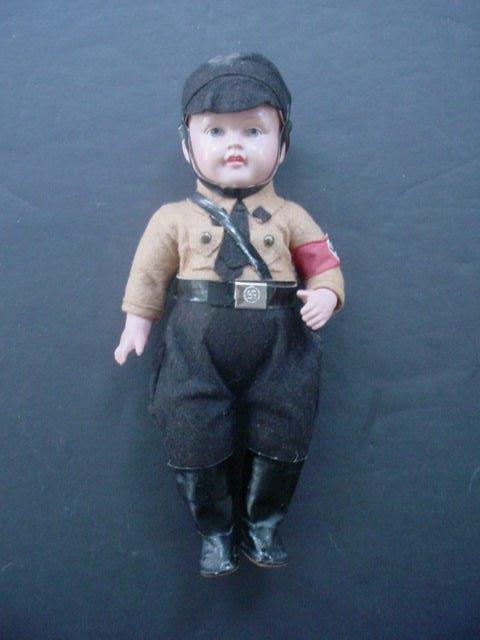
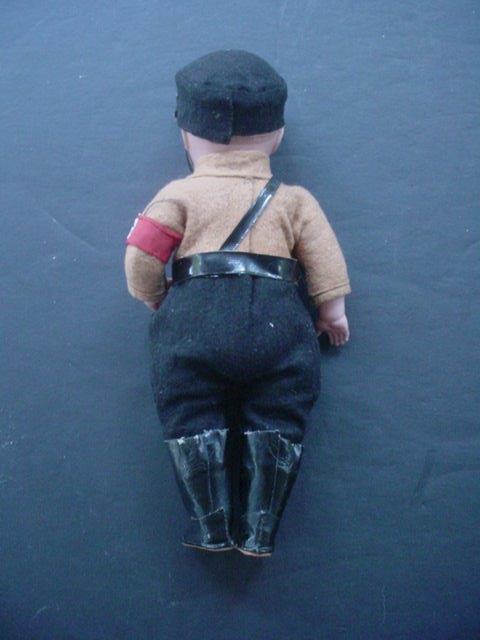
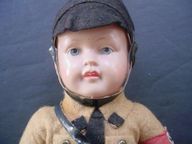
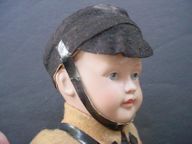
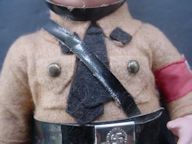
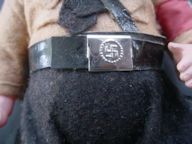
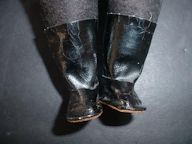
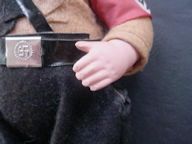
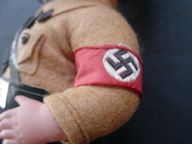
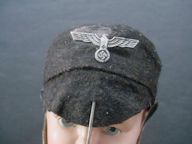
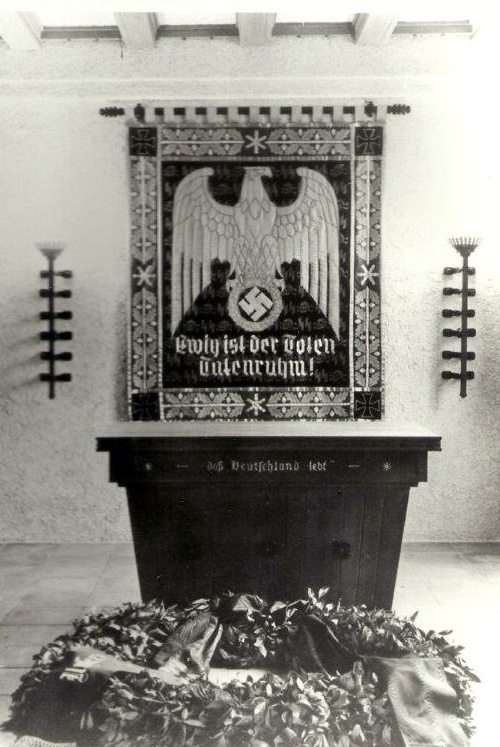
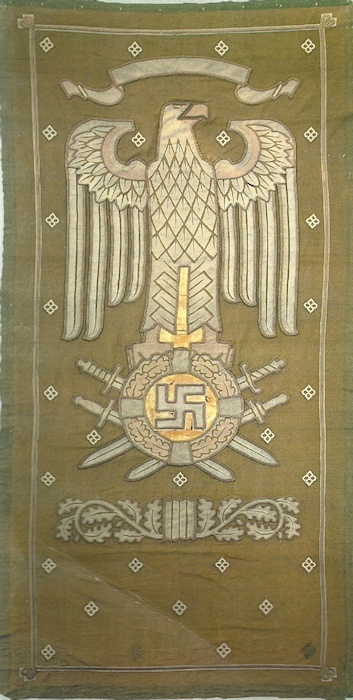
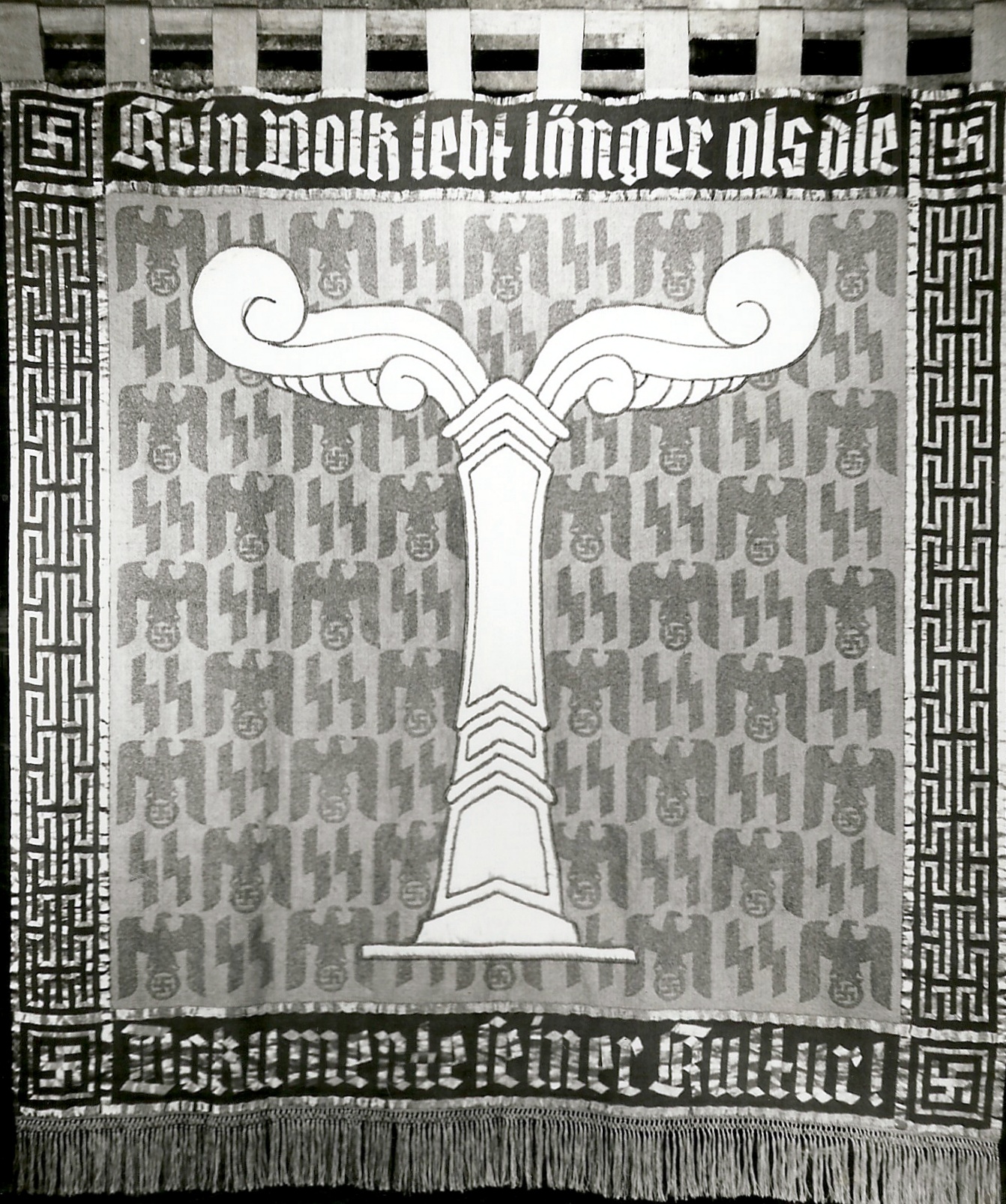
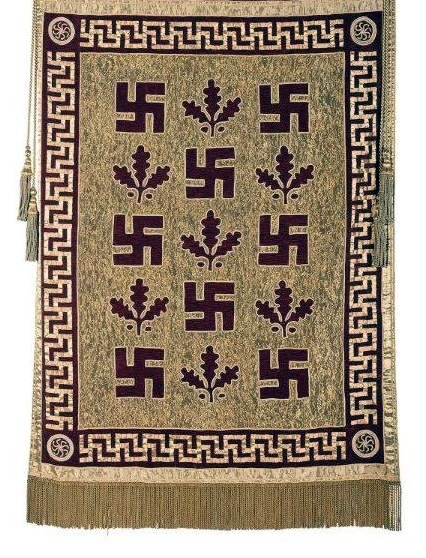
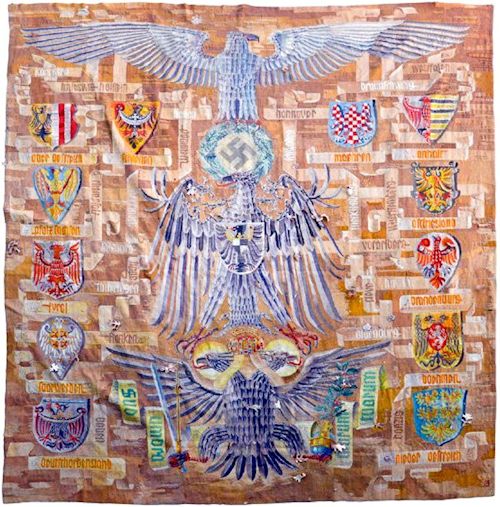
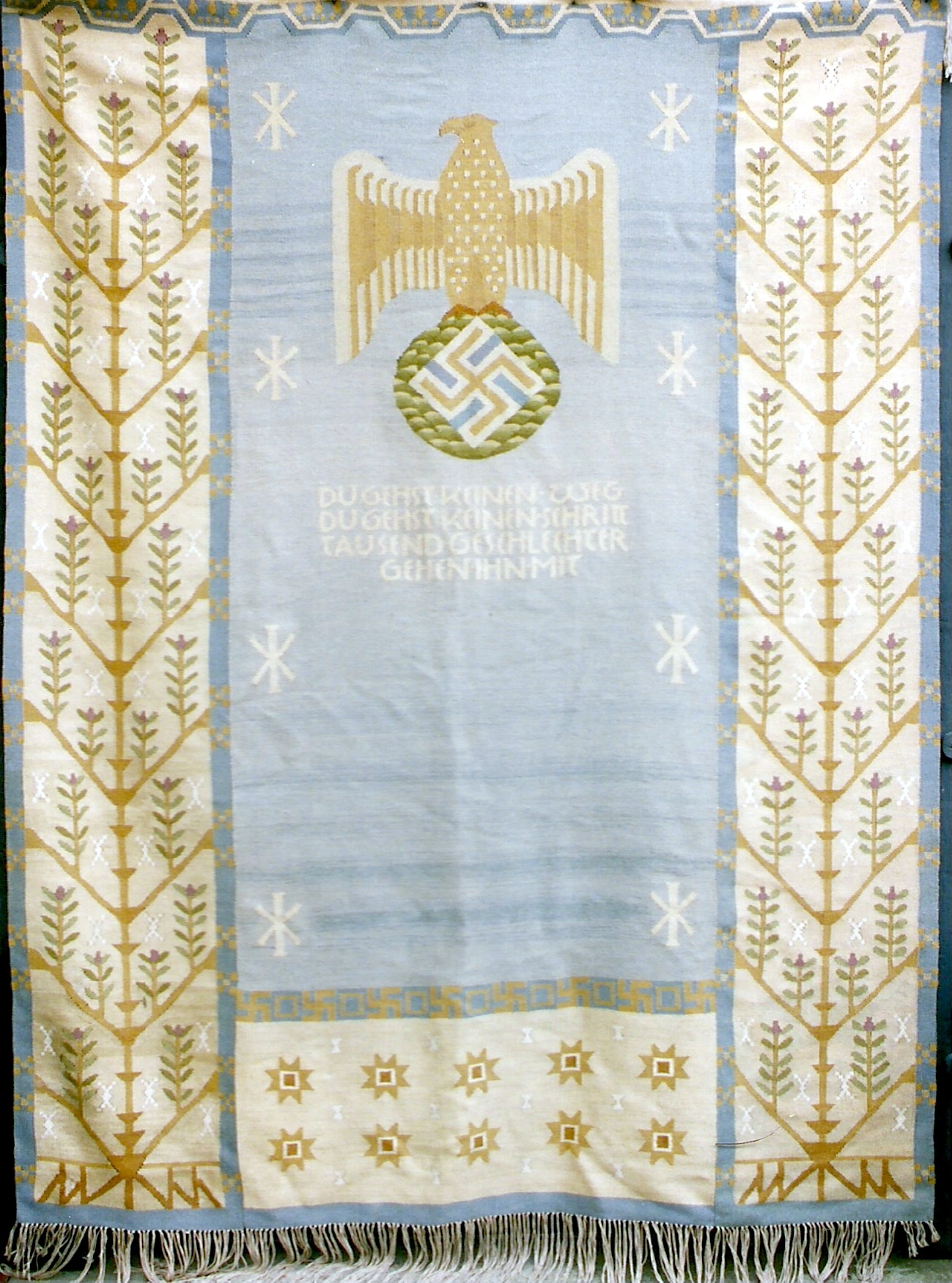
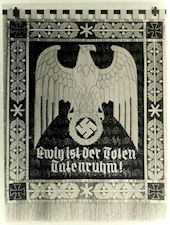
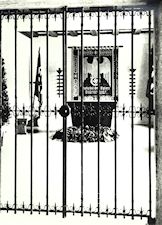
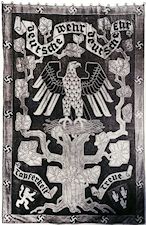
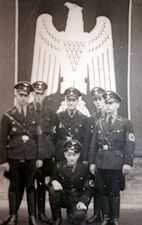
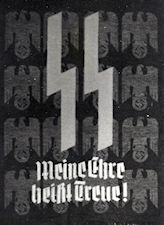
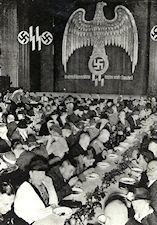
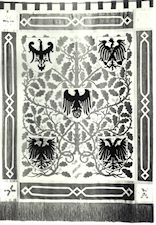
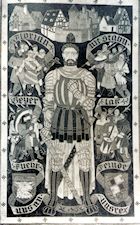
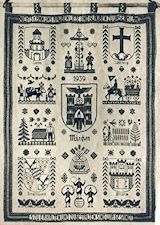
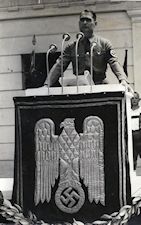
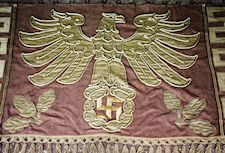
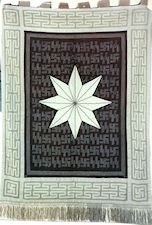
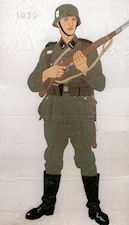

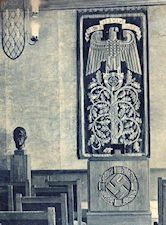
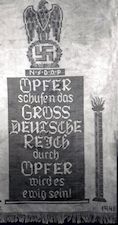
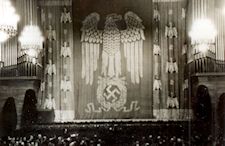
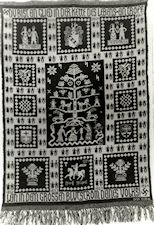
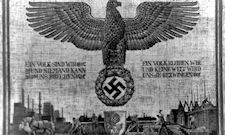
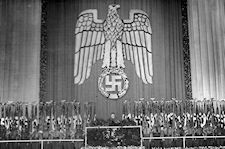
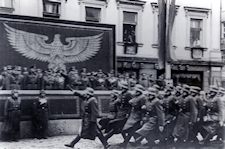
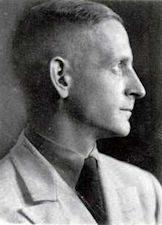
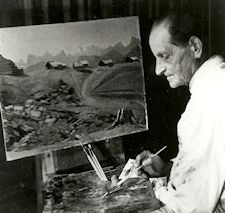
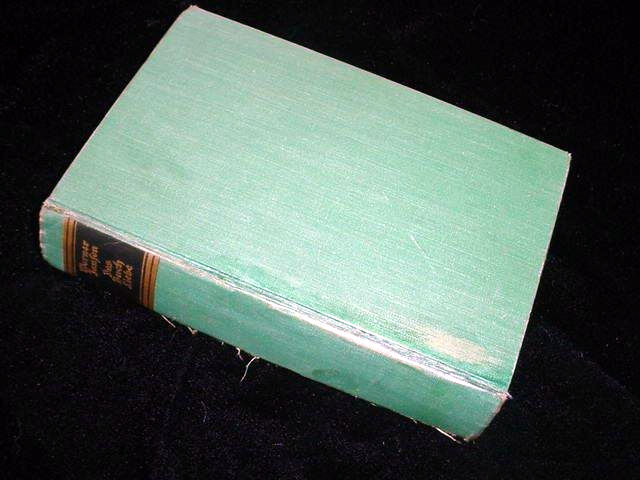
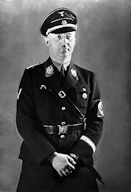
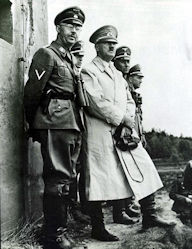
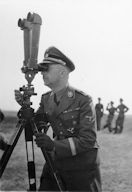
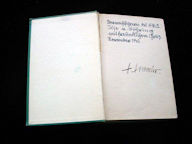
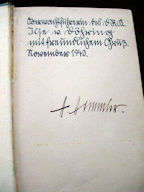
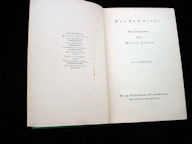
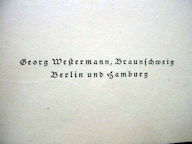
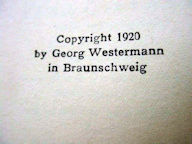
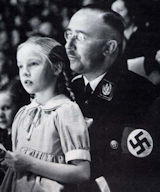
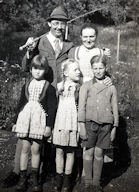
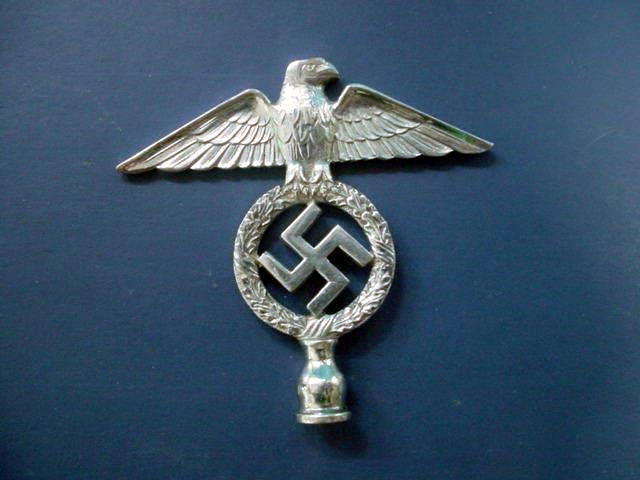
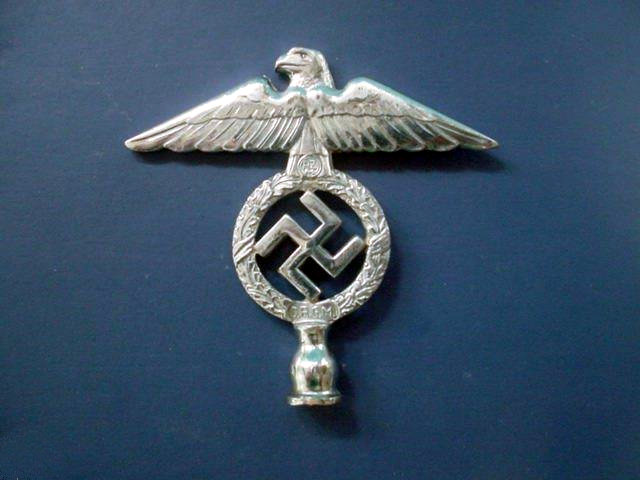
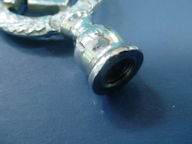
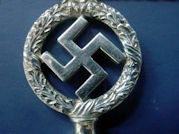
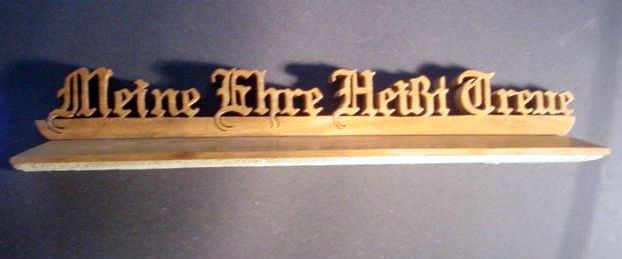
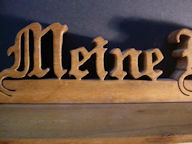
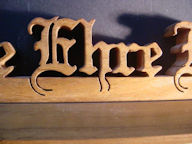
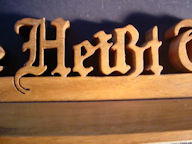
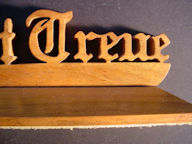
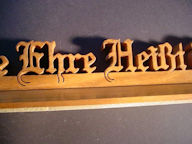
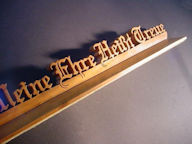
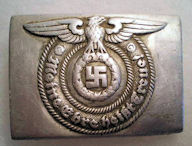
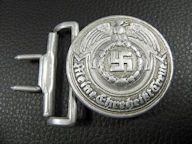
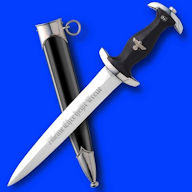
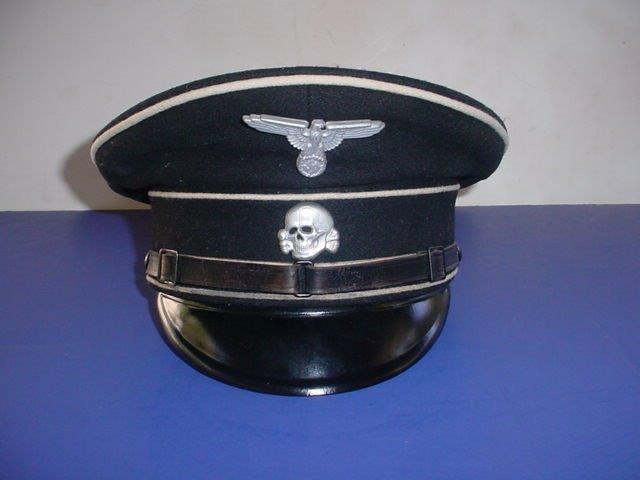
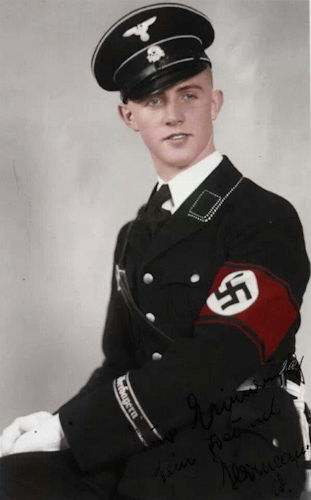
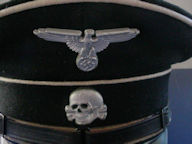
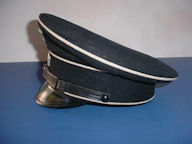
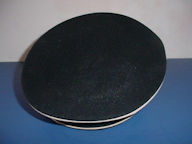
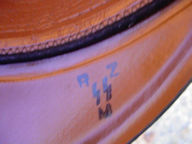
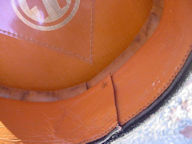
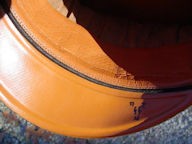
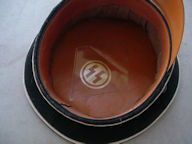
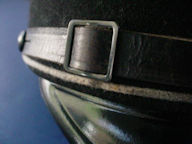
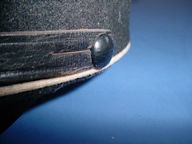
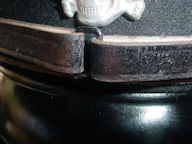
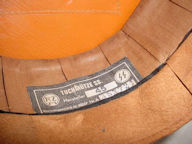
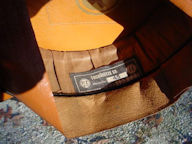
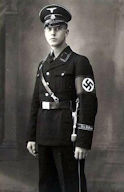
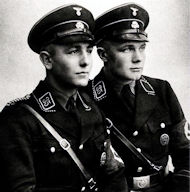
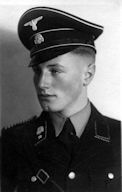

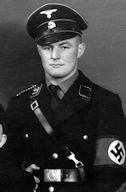
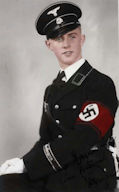
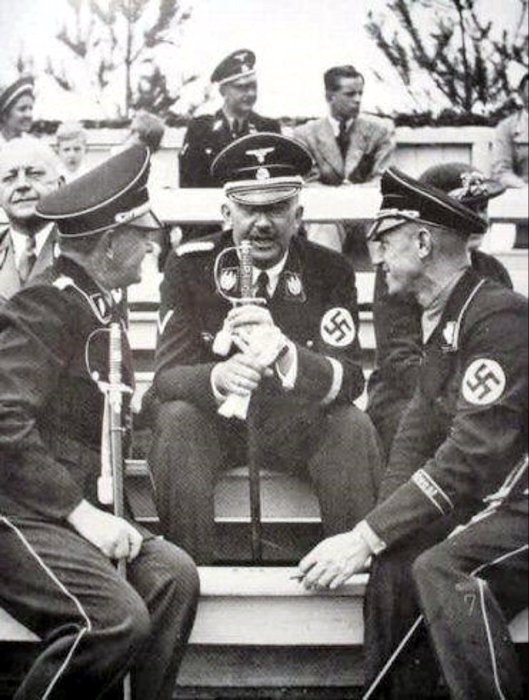
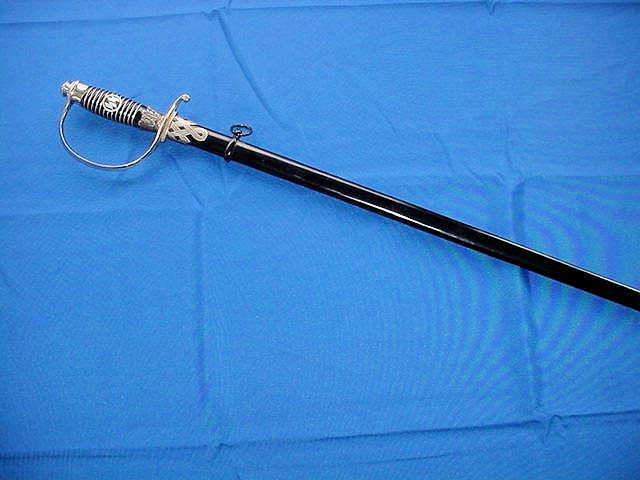
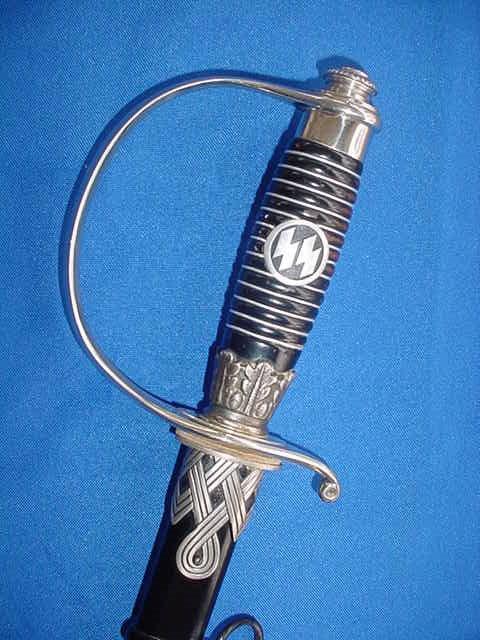
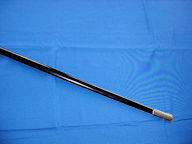
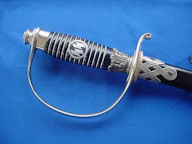
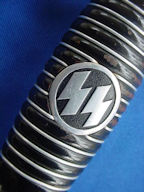
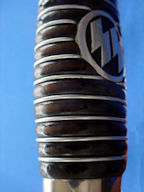
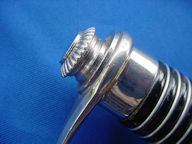
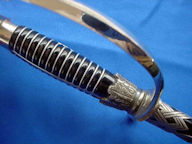
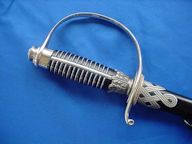
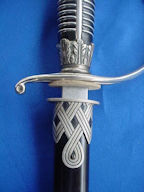
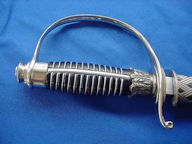
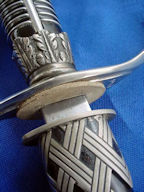
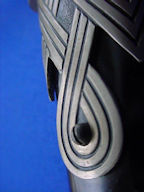
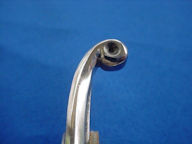
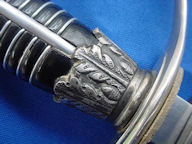
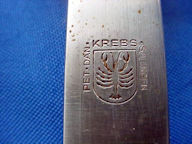
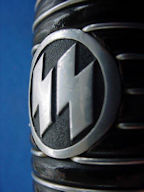
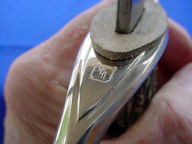
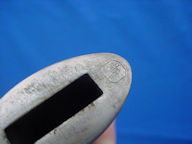
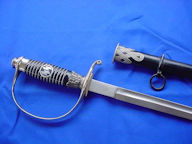
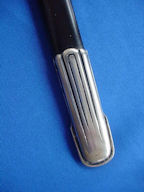
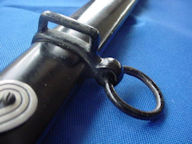
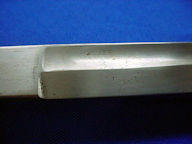
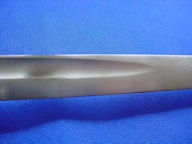
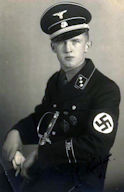
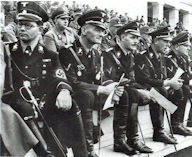
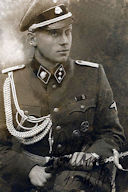
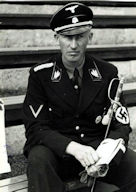
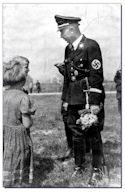
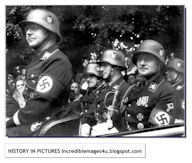

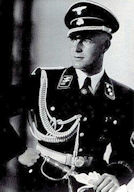
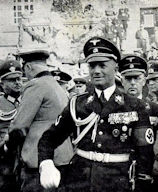
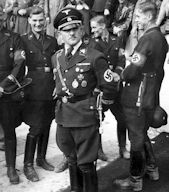
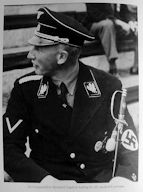
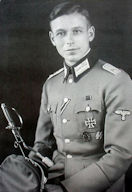
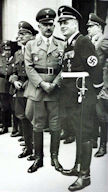
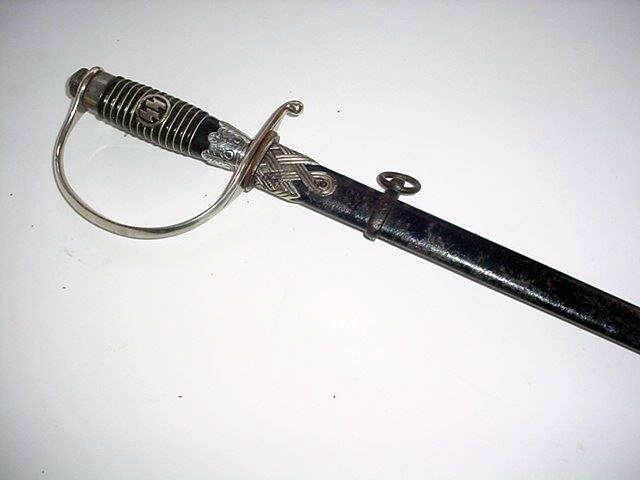
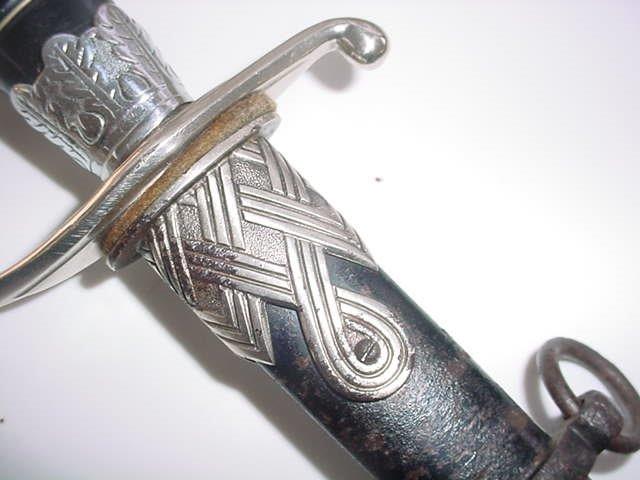
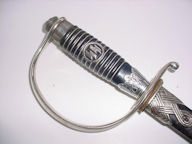
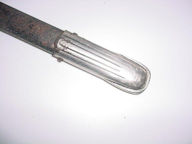
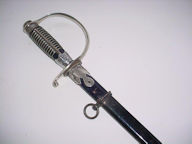
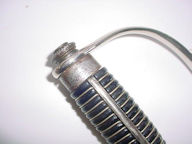
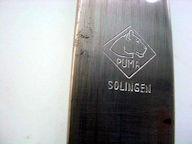
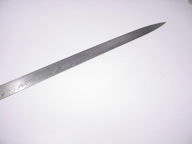
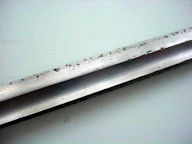
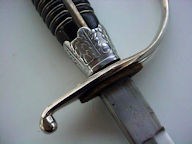
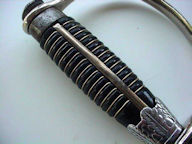
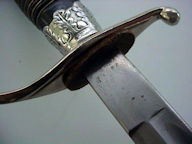
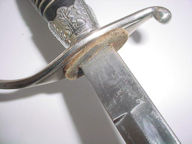
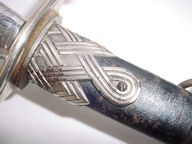
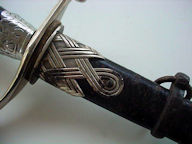
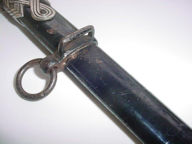
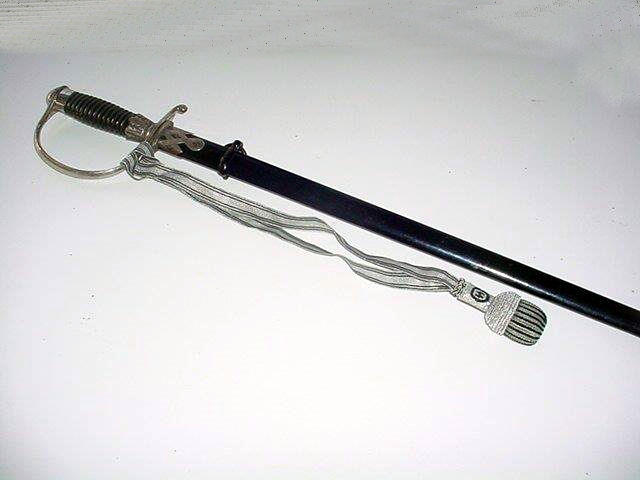
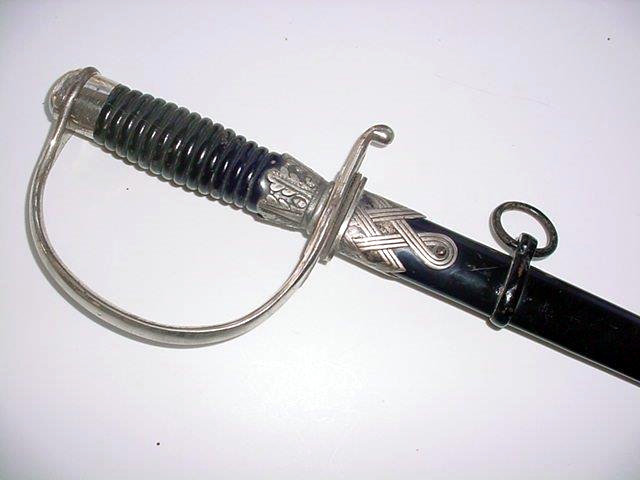
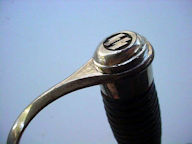
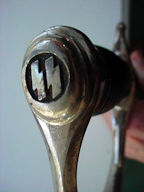
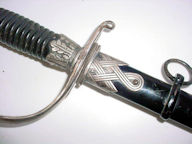
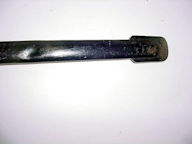
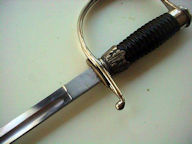
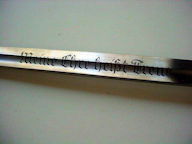
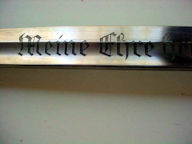
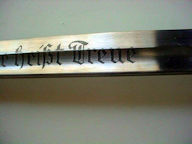
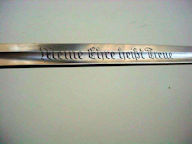
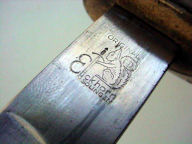
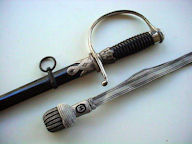
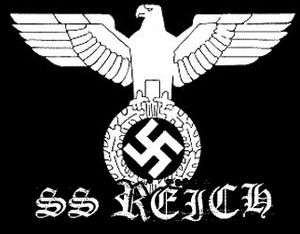
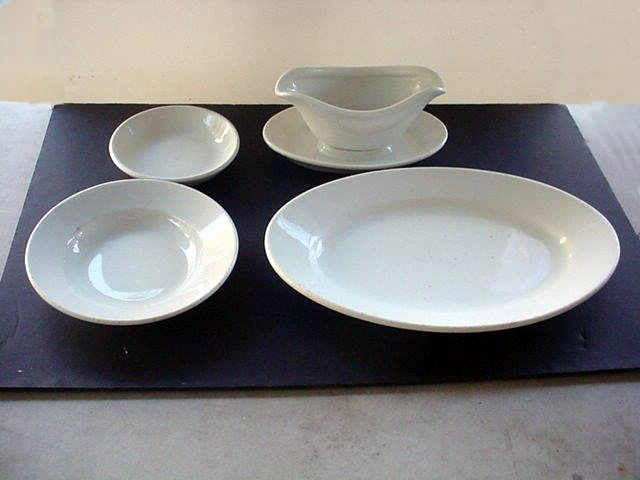
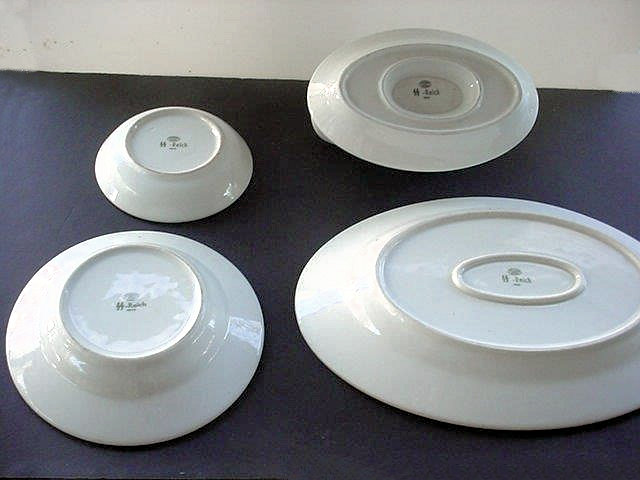
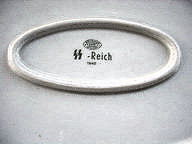
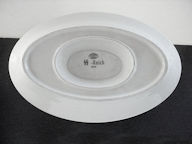
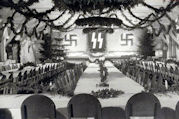
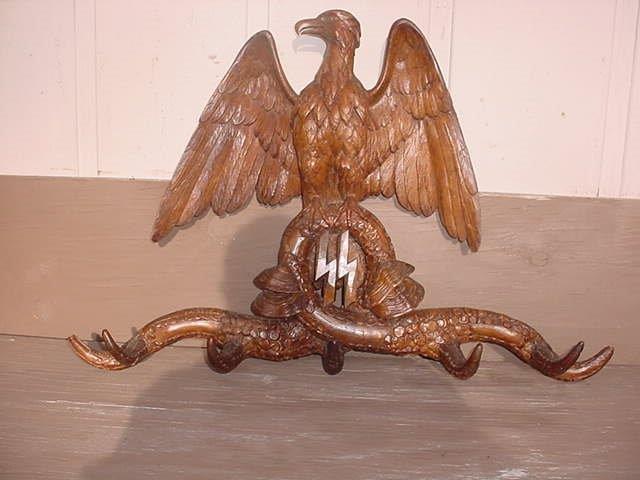

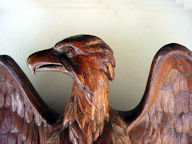
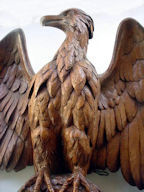
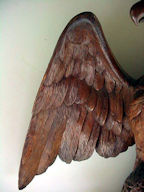
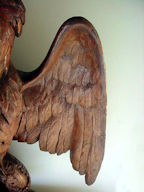
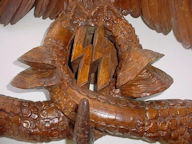
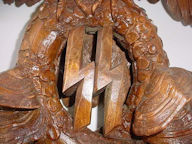
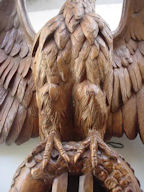
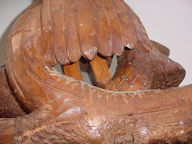
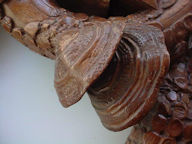
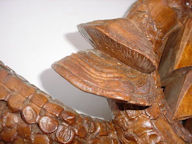
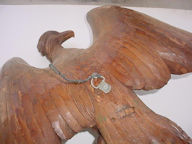
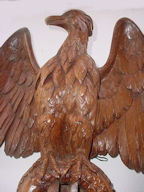
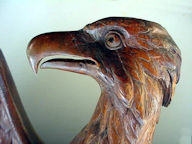
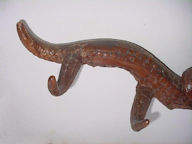
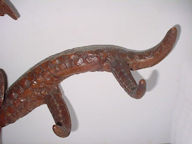
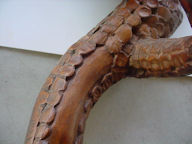
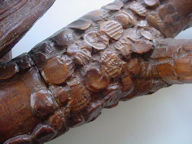
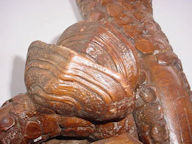
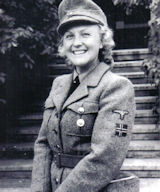
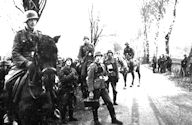
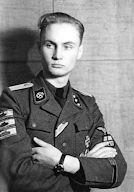
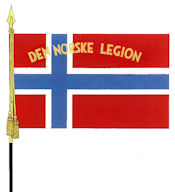
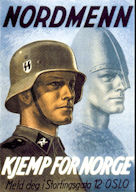

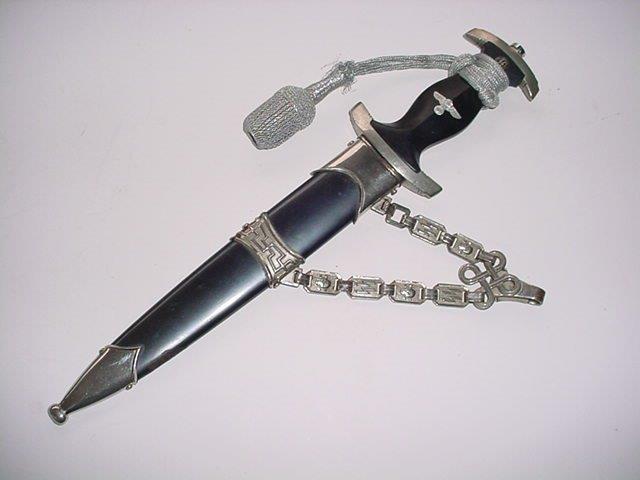
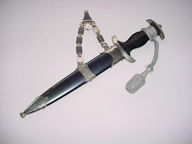
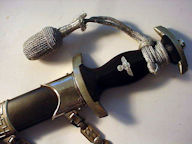
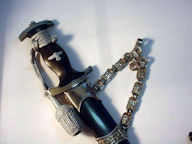
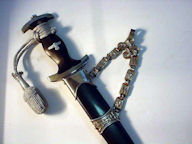
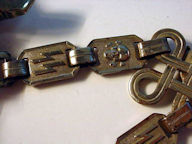
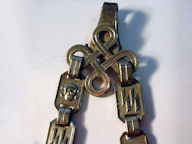
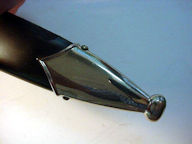
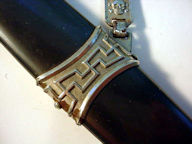
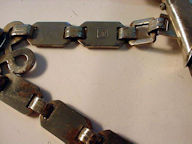
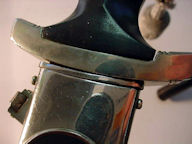
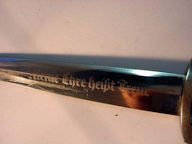
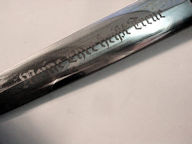
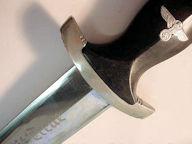
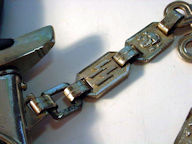
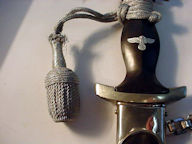
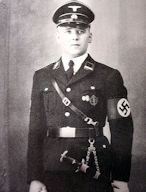
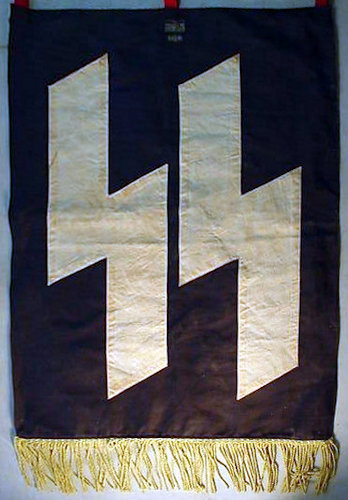
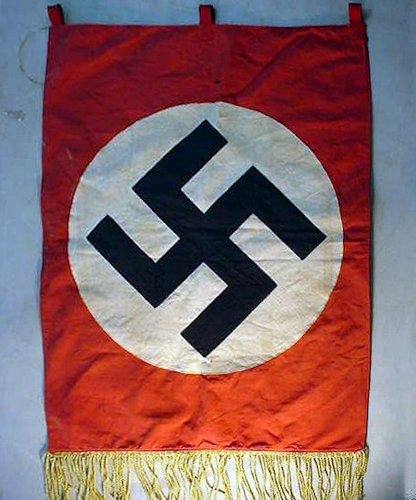
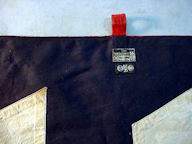
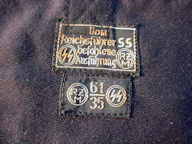
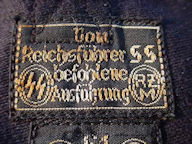
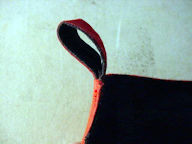
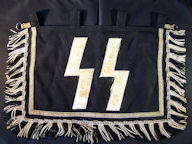
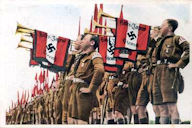
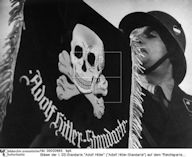
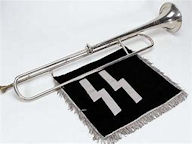
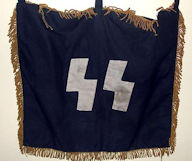
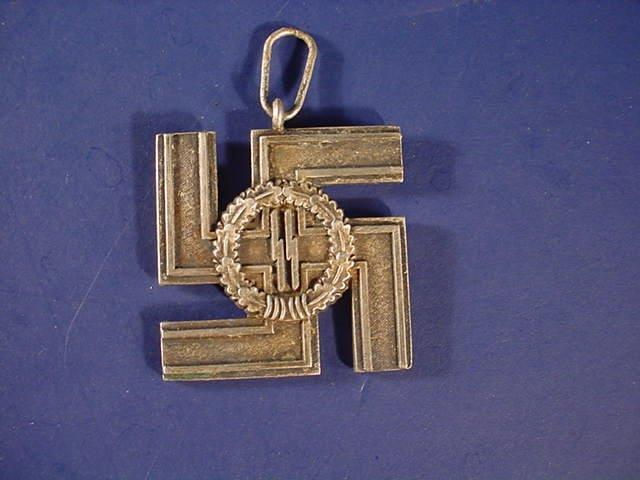
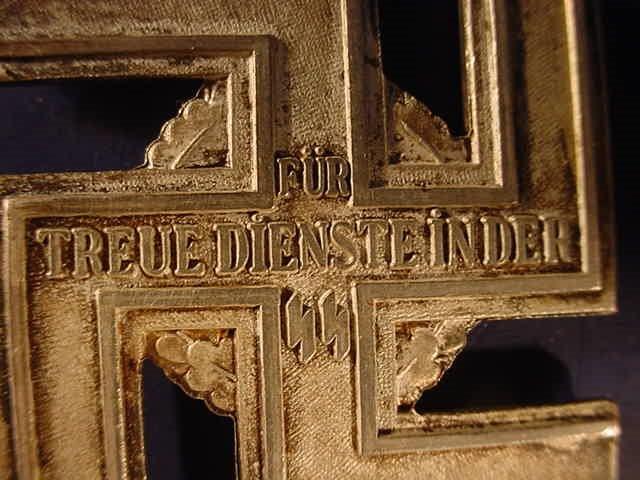
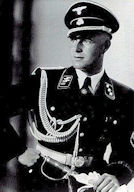
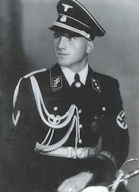
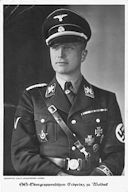
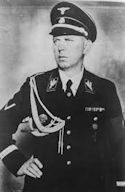
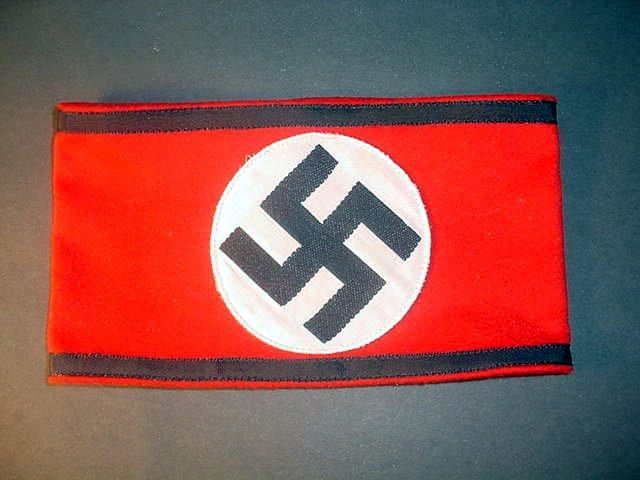
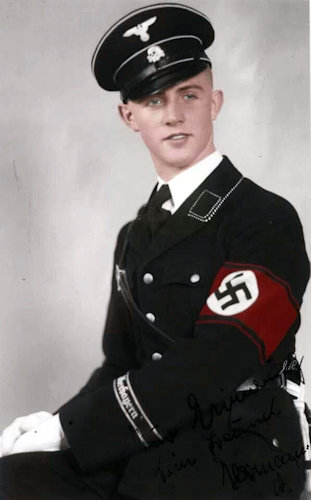
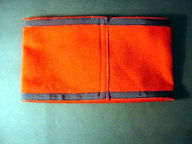
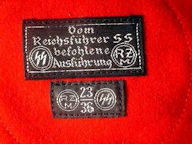
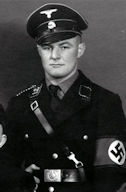
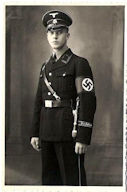
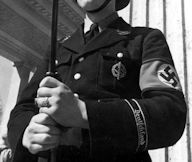
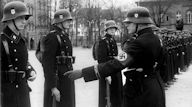
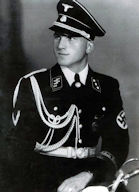
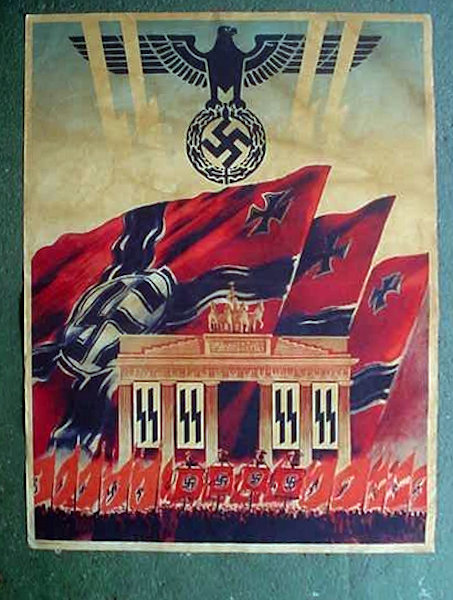
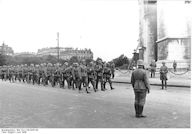
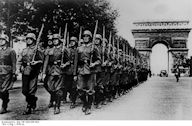
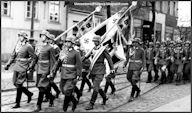
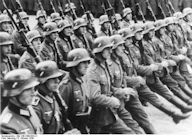
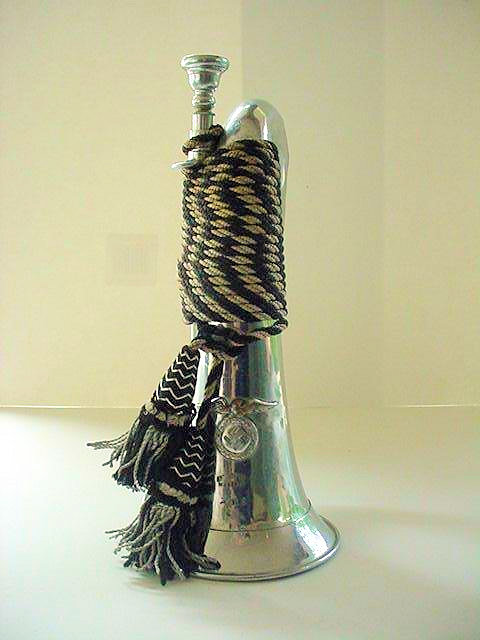
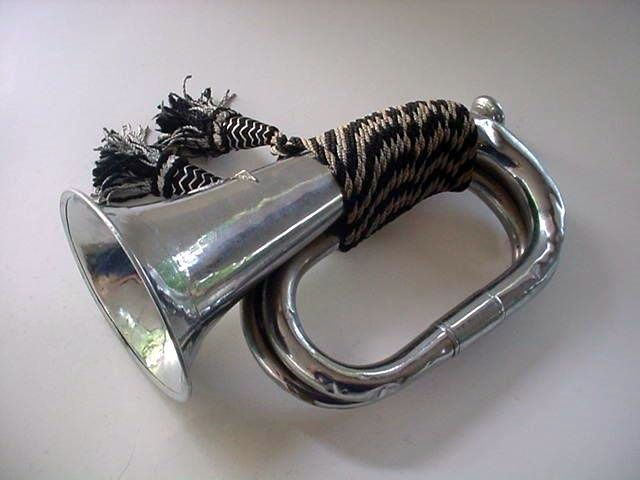
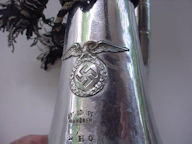
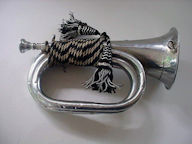
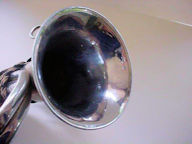
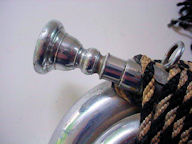
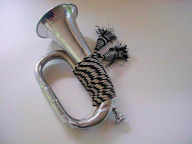
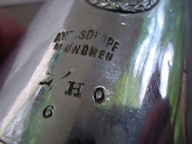
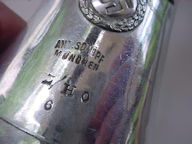
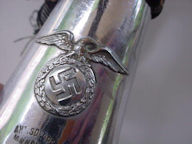
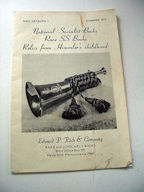
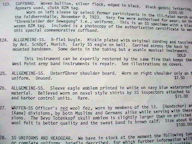
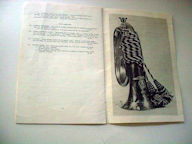
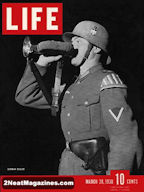
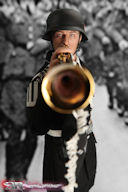
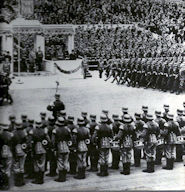
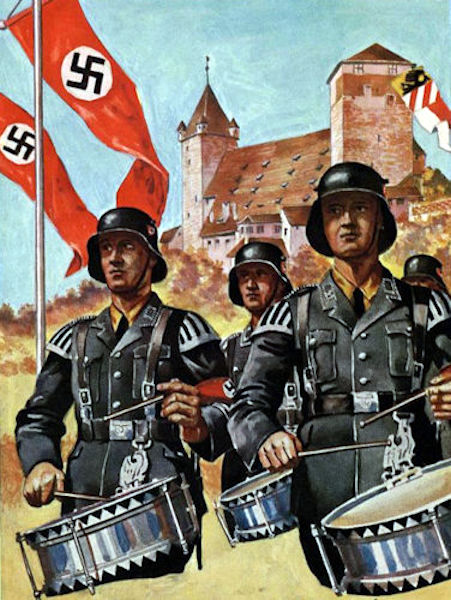
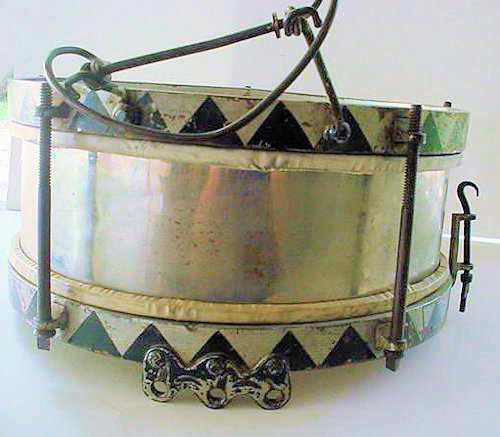
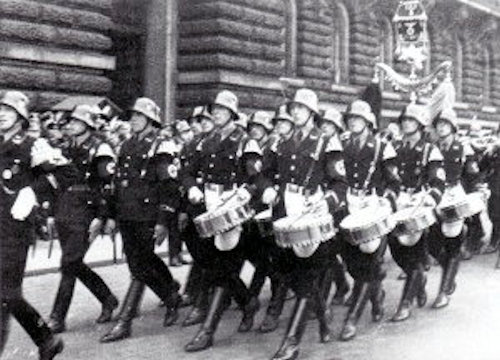
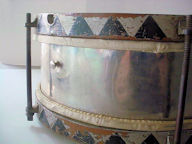
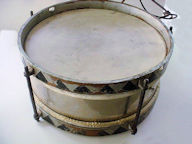
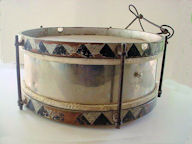
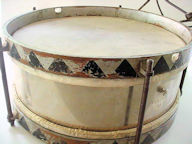
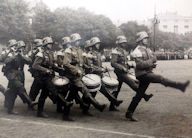
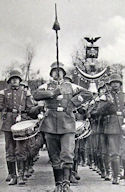
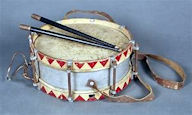
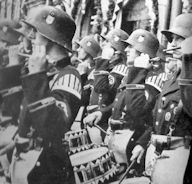
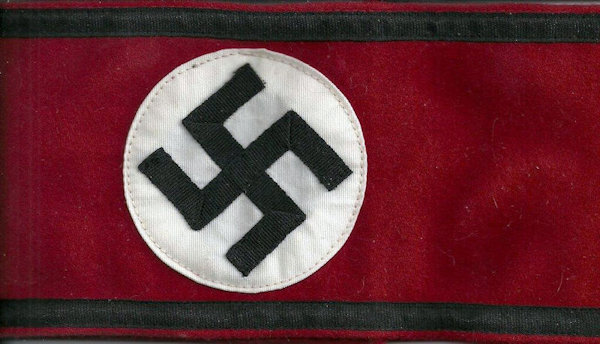
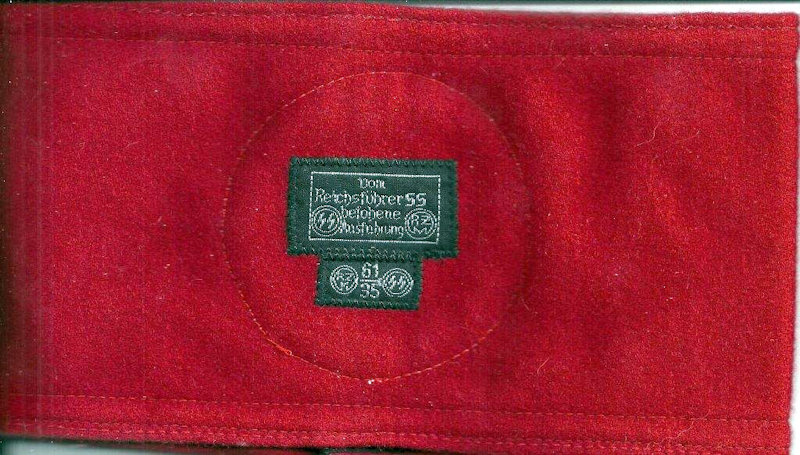
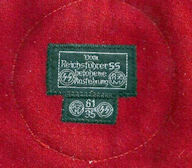
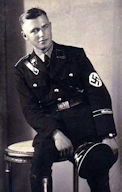
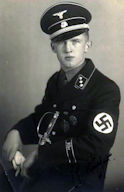
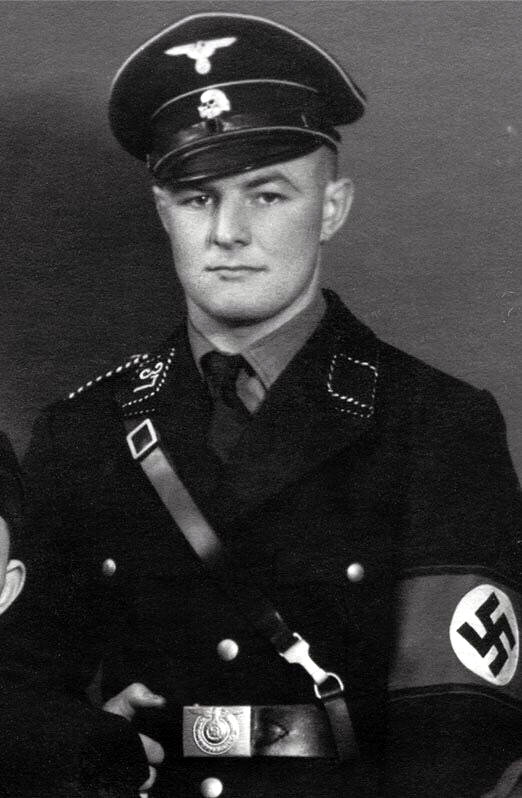
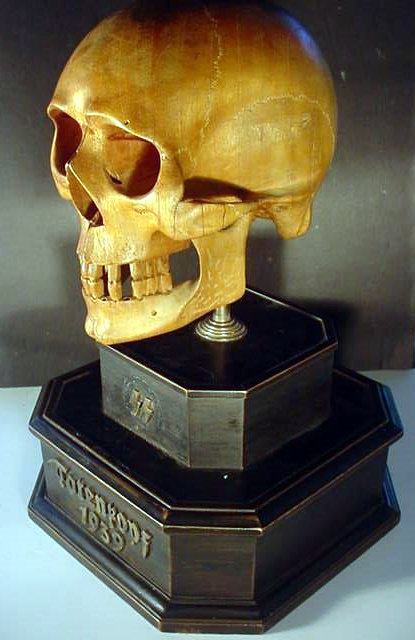
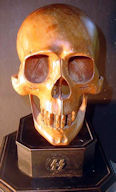
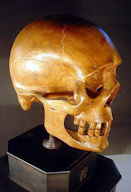
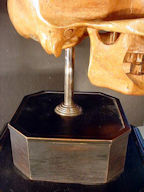
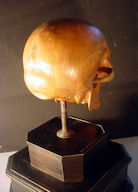
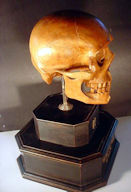
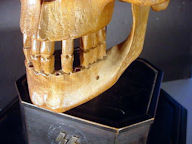
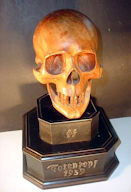
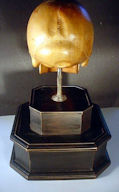
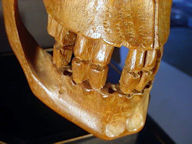
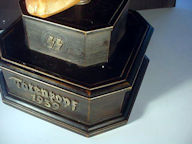
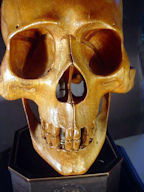
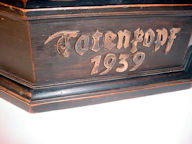
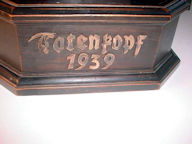
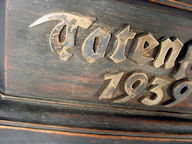
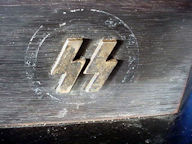
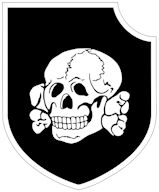
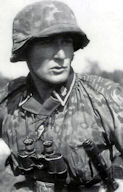
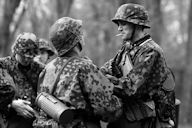
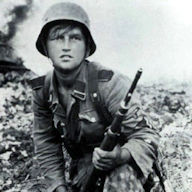
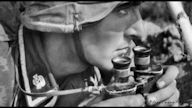
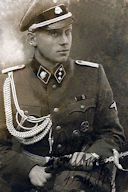
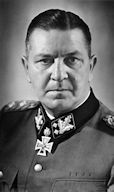
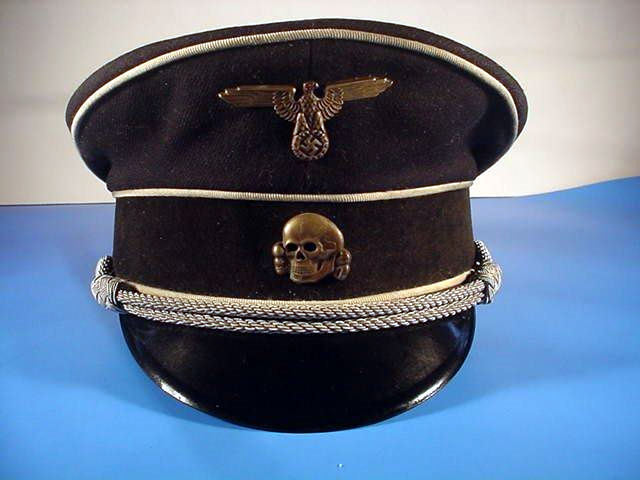
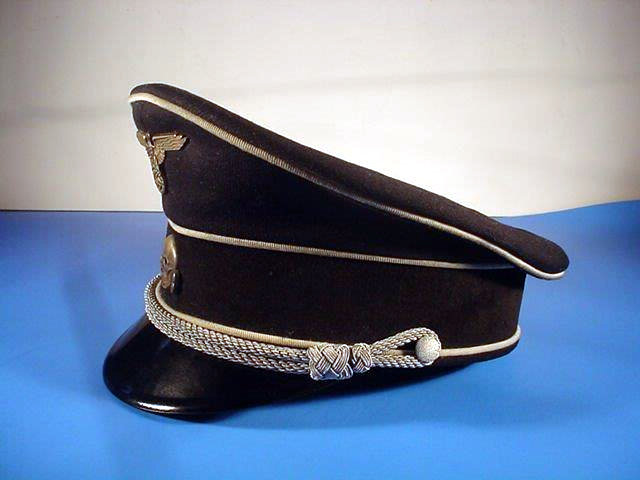
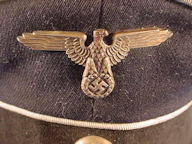
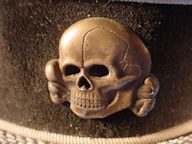
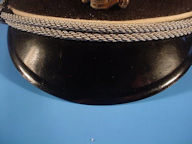
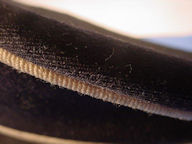
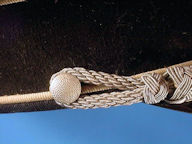
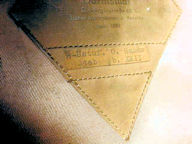
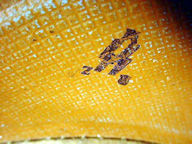
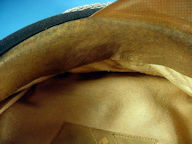
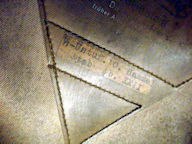
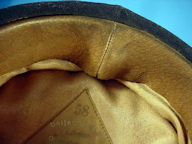
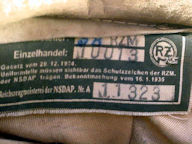
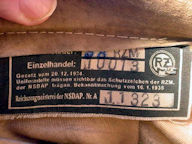
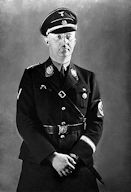
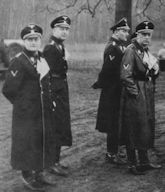
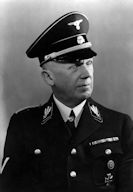
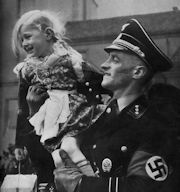
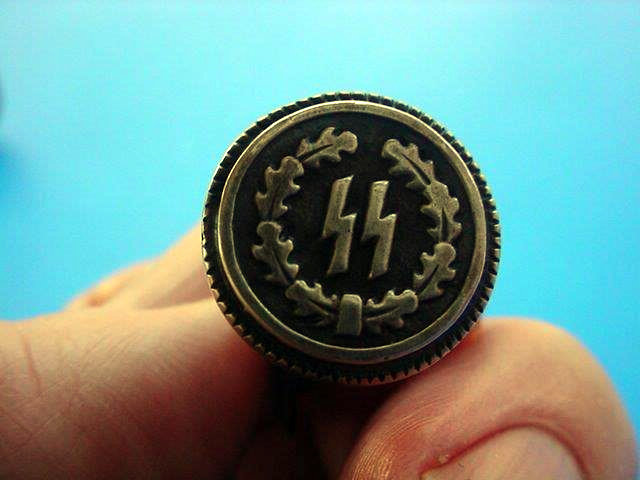
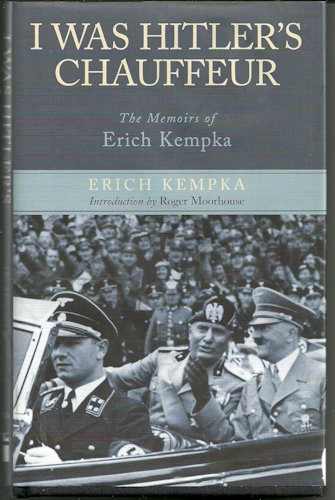
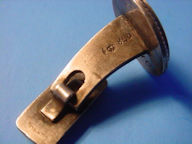
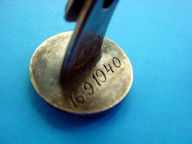
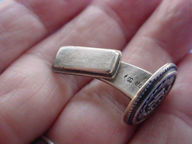
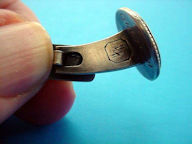
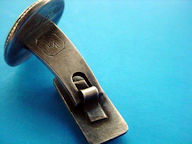
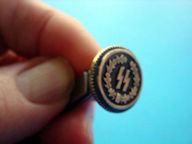
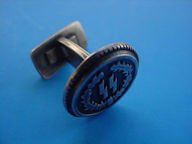
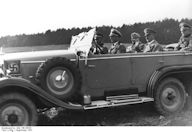

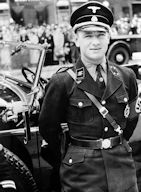
.jpg)
.jpg)
